The Panasonic Z85A is a basic OLED model from the Japanese manufacturer that fully utilizes the potential of its panel. Thanks to OLED technology, we can count on phenomenal image quality in the highest resolution – perfect blacks, excellent contrast, and great HDR effects, especially after professional calibration. In addition, there is a full set of supported HDR formats, so we can easily choose a movie in the best possible quality. Although Panasonic is usually associated with home cinema equipment, the Z85A performs just as well for sports and gaming. The 120 Hz panel, support for VRR, ALLM, and even working Dolby Vision in games guarantee smooth gameplay without motion blur. The sound is also commendable – although there is no flashy soundbar like in the model Z95A, it is still quite pleasant with noticeable bass. Drawbacks? Primarily Amazon Fire TV – an operating system that still has growing pains. Many popular applications are missing, and some features are unavailable or poorly translated (e.g., lack of support for external subtitles). Another issue is the not very high brightness, typical of older WOLED panels – this can be a problem in a heavily sunlit room. Despite these shortcomings, the Panasonic Z85A is a great option for movie enthusiasts and gamers looking for a versatile TV with exceptional image quality and solid sound. If we can overlook some limitations of the system and the not-so-high brightness, the Z85A still has a lot to offer. However, if full comfort of use and a richer app ecosystem are crucial for us, it’s worth considering other OLED TVs from competitors as well.
- Matching (Score)
- Our verdict
- TV appearance
- Where to buy
- Contrast and black detail
- HDR effect quality
- Factory color reproduction
- Color reproduction after calibration
- Smoothness of tonal transitions
- Image scaling and smoothness of tonal transitions
- Blur and motion smoothness
- Console compatibility and gaming features
- Input lag
- Compatibility with PC
- Viewing angles
- TV efficiency during daytime
- Details about the matrix
- TV features
- Apps
- Playing files from USB
- Sound
Panasonic Z85A vs TCL C7K / QM7K 55"-85"
Direct compare
Check the best price offer:
Panasonic Z85AC7K / Q7C / MQLED85K / C79K / C71K / QM7K

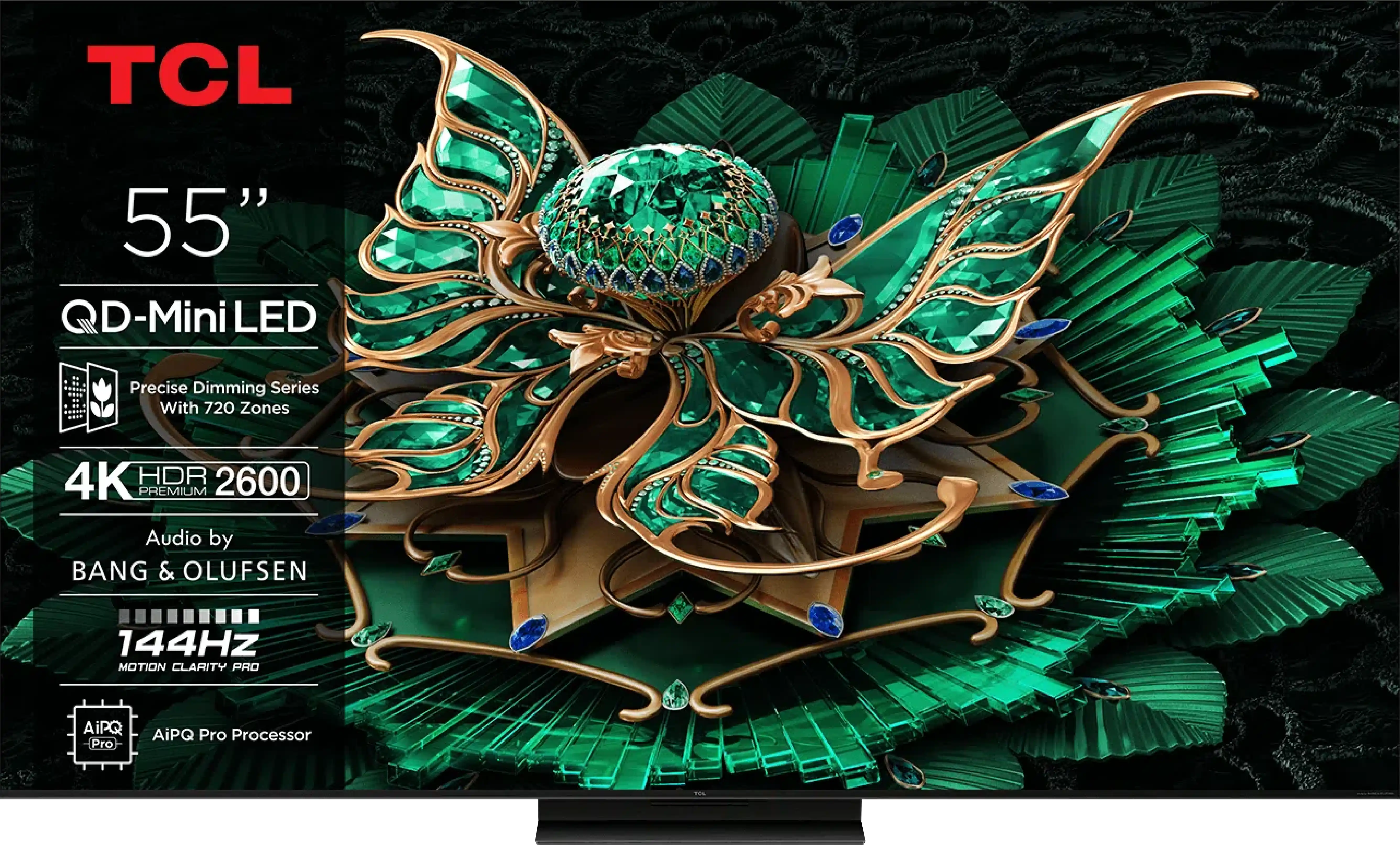
Panel type: WRGB OLED
Resolution: 3840x2160
System: Amazon FireTV
Model year: 2024
Complete the survey to find out the result

Panel type: LCD VA
Resolution: 3840x2160
System: Google TV
Model year: 2025
Complete the survey to find out the result

Overall rating
7.7
7.4
Movies and series in UHD quality
8.2
7.2
Classic TV, YouTube
8.7
6.9
Sports broadcasts (TV and apps)
8.5
6.8
Gaming on console
9.3
8.7
TV as a computer monitor
7.6
8.4
Watching in bright light
4.8
6.4
Utility functions
7.0
7.3
Apps
5.7
9.6
Sound quality
7.4
7.7
Complete the survey to find out what fits your preferences
Advantages
Perfect black and infinite contrast thanks to WOLED panel
Great HDR quality with good DCI-P3 color gamut coverage (98%)
Excellent image quality after professional calibration
Complete HDR package: HDR10, HDR10+, Dolby Vision
Low input lag: 5 ms (120 Hz) and 13 ms (60 Hz)
Support for ALLM, VRR, HGIG, and Dolby Vision in gaming
Very good viewing angles
Smooth motion without ghosting thanks to 120 Hz OLED panel
USB recording capability and PiP feature
AirPlay support
Pleasant sound quality with noticeable bass
Very good black - VA panel with a large number of Mini-LED zones
High brightness in HDR - over 1000 nits
Great for gamers - HDMI 2.1, low input lag, VRR, ALLM, etc.
Good motion fluidity - 144Hz panel
Supports multiple HDR formats: HDR10, HDR10+, Dolby Vision
Google TV operating system with access to a huge app library
Pleasant sound from built-in speakers (6.2.2) Bang & Olufsen
Disadvantages
SDR brightness at 300 nits - too low for heavily sunlit rooms
Amazon Fire TV system has a limited number of applications
Some system functions poorly translated into Polish
No support for external subtitles in USB player
No support for DTS:X audio in the television
Google TV can work with minor stutters
No USB recording and PiP function
Our verdict
There are TVs that make it to reviews and at first glance seem like just another "mediocre" model. The TCL C7K looks just like that – without big slogans about revolution, without ambitions to dethrone OLEDs. Yet after spending a few days with this model, it's hard not to come to the conclusion that it's truly a successful piece of equipment. The biggest advantages? Very good picture quality at a reasonable price. MiniLED combined with a QLED filter delivers vibrant colors, high brightness, and contrast that really impresses in this class. Motion in sports or games looks smooth, and the presence of HDMI 2.1 and 144 Hz refresh rate makes gaming on this model pure enjoyment. Additionally, the Google TV system offers a huge range of possibilities: from voice control, to AirPlay support, to access to all the most important applications.
Are there any drawbacks? Yes. MiniLED still has its limitations, and in the most challenging movie scenes, compromises in dimming can be noticeable. Google TV also doesn't always operate perfectly smoothly. But these are rather minor issues that do not overshadow the overall picture – which is truly positive. It’s also worth highlighting the difference between variants. The 50-inch version we tested can be surprising, but the 55–85 inch models perform distinctly better – they have more backlight zones, even better contrast quality, and superior sound. Therefore, if you're considering purchasing the C7K, it's definitely worth going for a larger size.
TV appearance




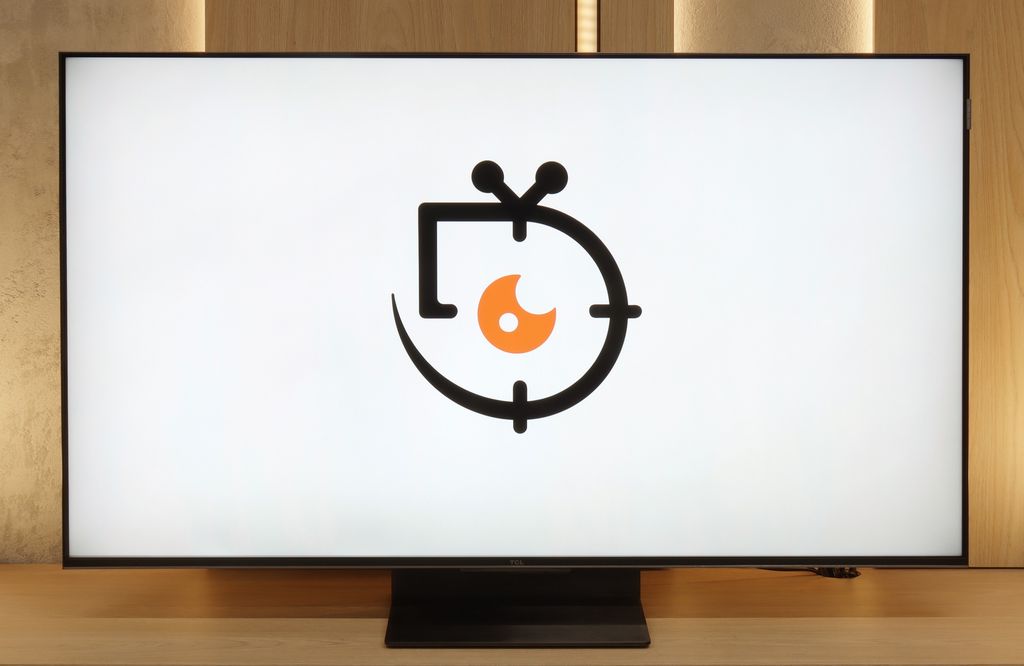
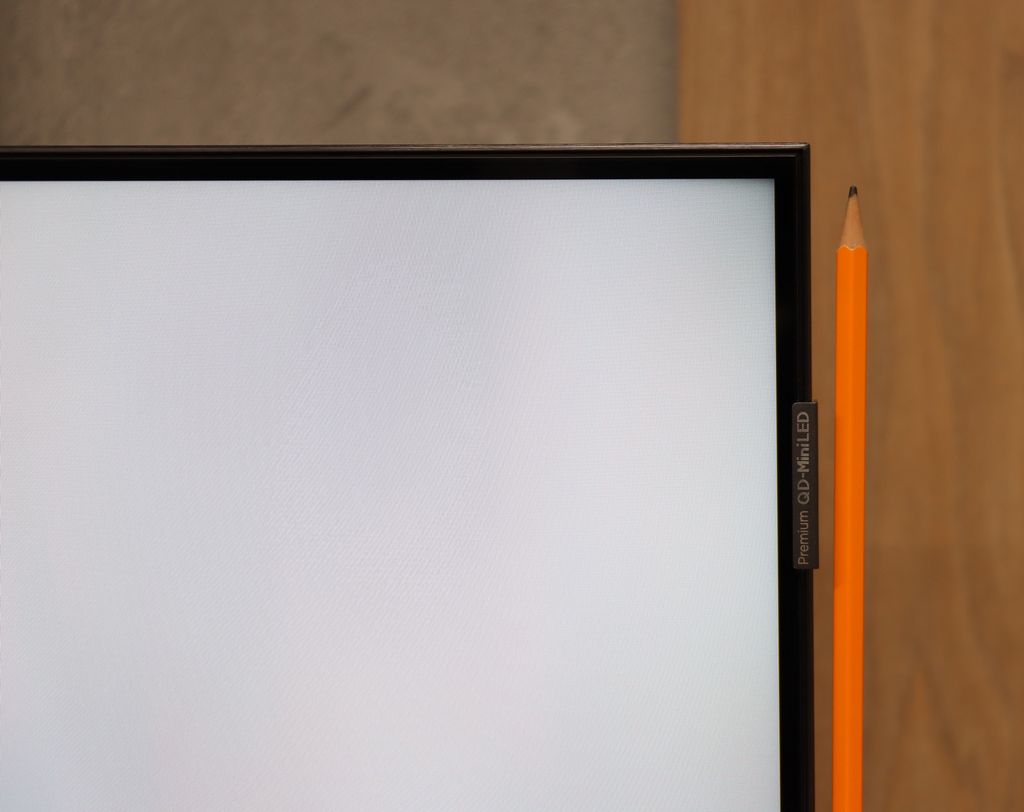
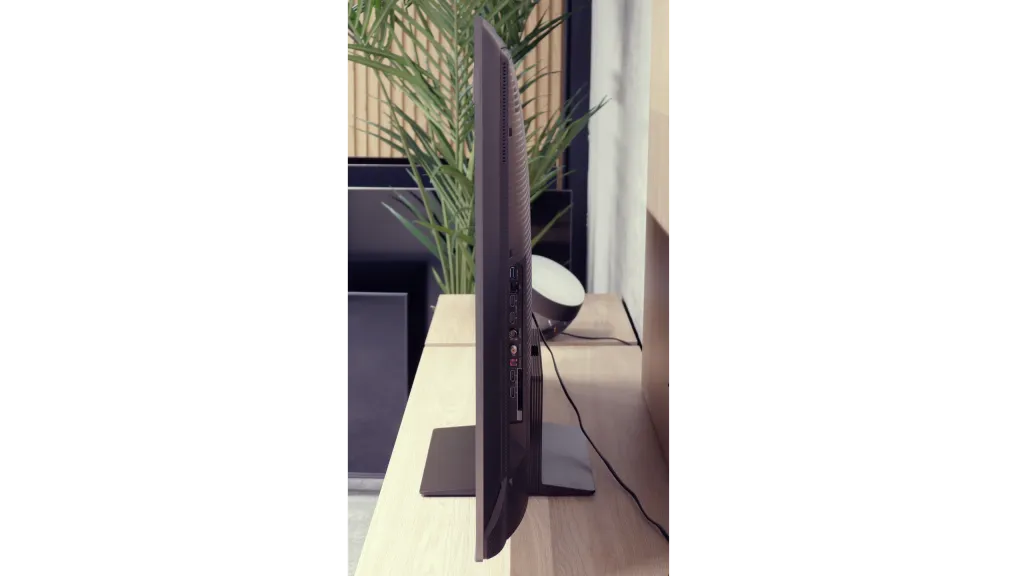
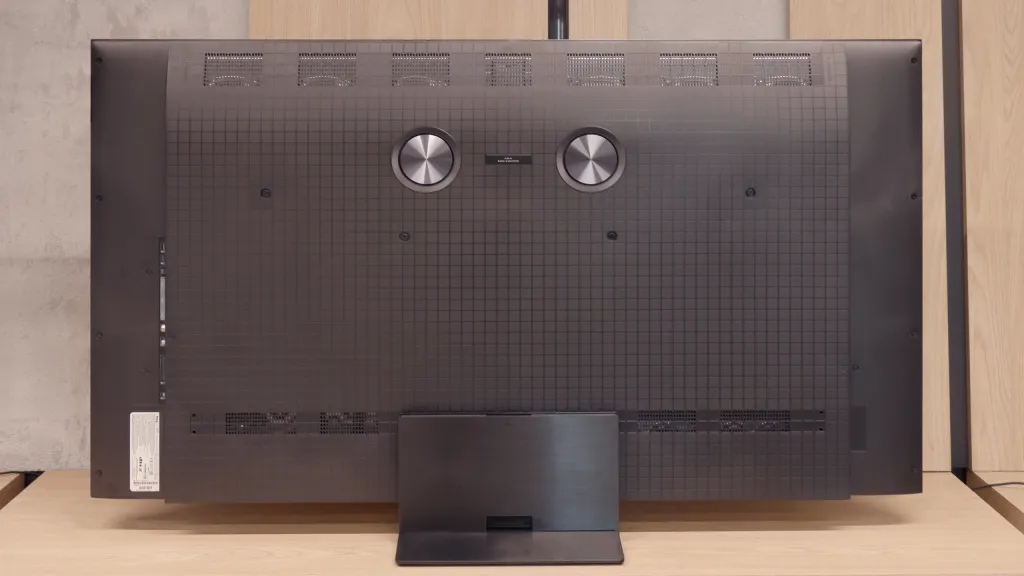
Contrast and black detail
10/10
8.1/10
Local dimming function: Yes, number of zones: 1008 (42 x 24)
Contrast:

Result
∞:1

Result
∞:1

Result
∞:1

Result
∞:1

Result
∞:1

Result
256,000:1

Result
59,850:1

Result
22,200:1

Result
16,850:1

Result
11,400:1
Halo effect and black detail visibility:

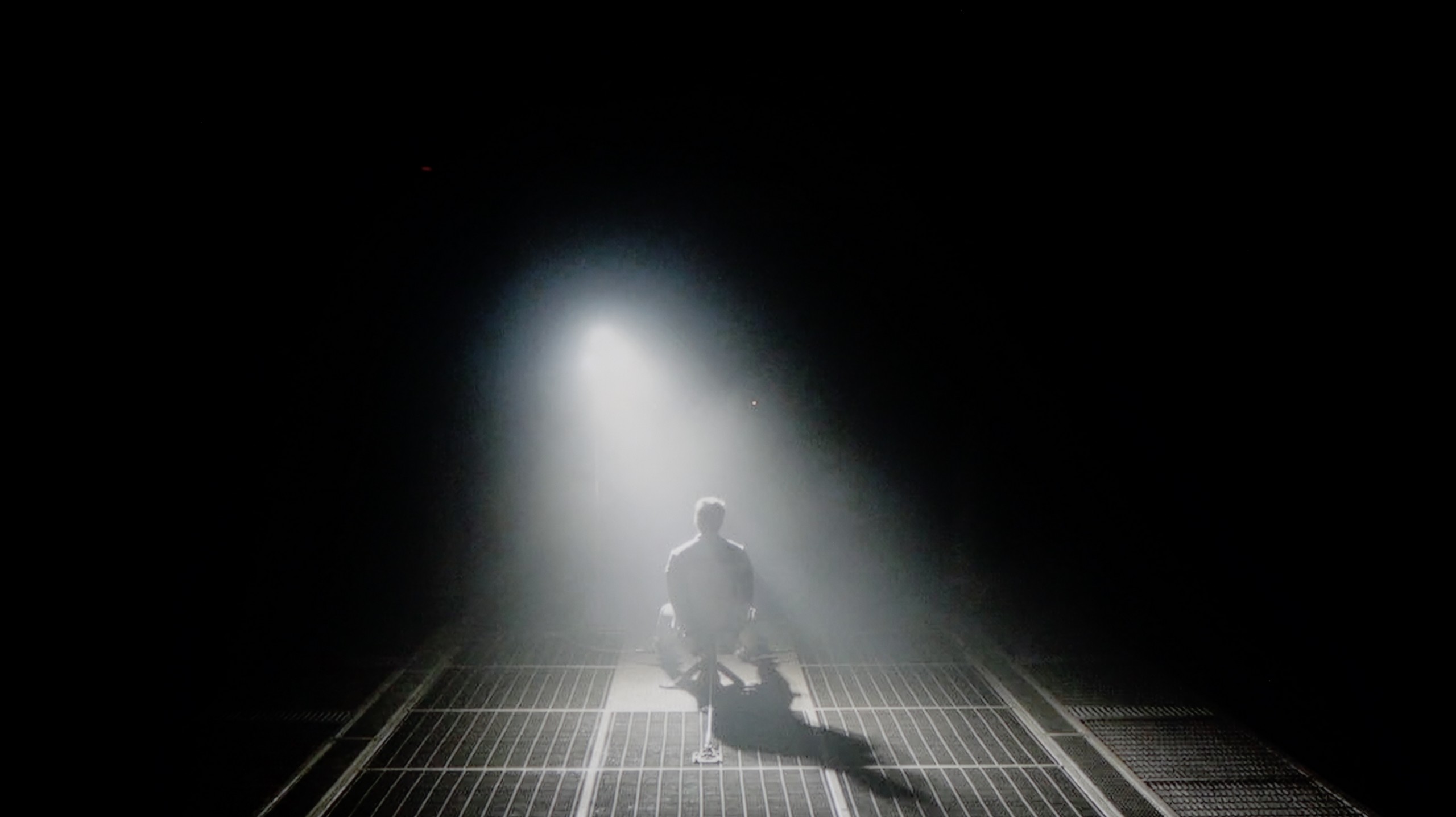
The Panasonic Z85A uses a WOLED panel, and that means one thing - perfect black and infinite contrast. Each pixel lights up and dims independently, so there are no streaks or halos around bright objects on the screen. Even in the most demanding scenes, the picture looks simply exemplary. In this regard, there is no room for compromises, which are still present even in the most expensive LCD televisions. Here, Panasonic shines, utilizing organic technology provided by LG Displays, and does so in a truly impressive style.
The results of black and contrast tests on models from 55 to 85 inches are very similar, which is why in the main part of the evaluation we refer to the 65-inch version. It is a natural phenomenon that larger sizes mean a greater number of backlight zones, and in the case of 65 inches, we counted over 1000. The effect is very good – the contrast is at a high level and is definitely better than in the smallest, 50-inch variant. Typical MiniLED limitations are still noticeable, such as the halo effect or a somewhat too aggressive dimming of the image, but here they are less perceptible than in the smaller model.
For comparison, it is worth recalling that the 50-inch TCL C7K, although surprising with its use of as many as 336 dimming zones, had difficulties managing the backlight in more complicated scenes – there were instances of overexposure or loss of detail. In larger sizes, this problem does not disappear completely, but thanks to a greater number of zones, its impact on the image perception is less bothersome.
HDR effect quality
6.5/10
6.2/10
Luminance measurements in HDR:

Result
812 nit

Result
775 nit

Result
812 nit

Result
808 nit

Result
390 nit

Result
1108 nit

Result
405 nit

Result
865 nit

Result
290 nit

Result
848 nit
Scene from the movie “Pan” (about 2800 nits)


Scene from the movie “Billy Lynn” (about 1100 nits)

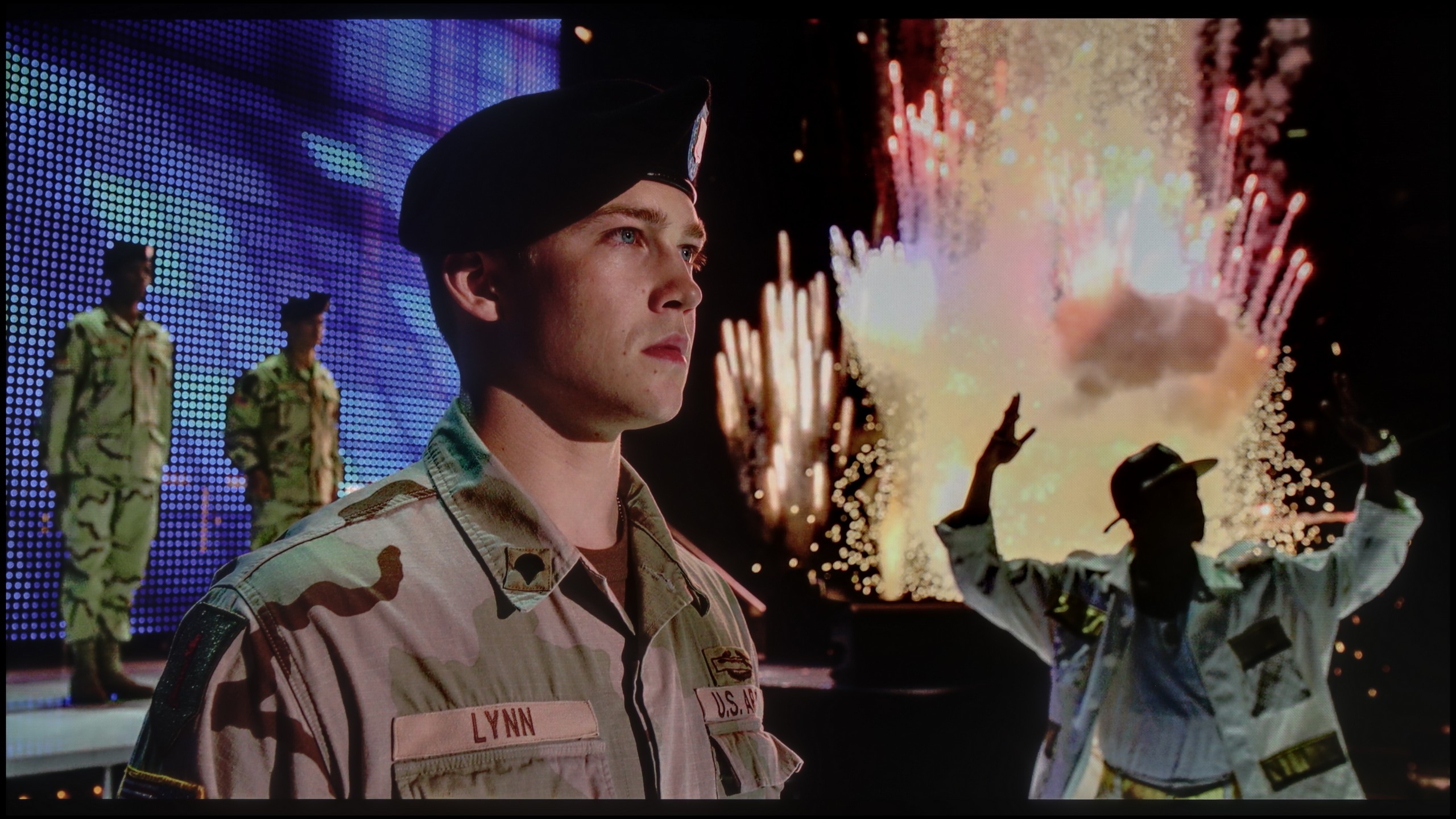
Static HDR10


Dynamic: Dolby Vision
Dynamic: Dolby Vision


HDR luminance chart:
TCL C7K / QM7K 55"-85"
HDR luminance
Panasonic Z85A
HDR luminance
Luminance of RGB colors
The Panasonic Z85A is an OLED television, so you can expect great effects in movies right away. And indeed – our tests show that the WOLED panel can achieve around 800 nits of peak brightness in optimal conditions. This is a solid result that performs well in most demanding HDR scenes, allowing you to enjoy a dynamic and detailed image. However, like every OLED, the Z85A has its limits. In very bright scenes that cover the entire screen – like the final sequence from the movie The Meg – the television reduces brightness to about 400 nits. This is standard behavior for this technology, so if someone plans to watch movies in a brightly lit living room, it's worth keeping this in mind. The coverage of the DCI-P3 color gamut at 98% also deserves a big plus. As a result, the television delivers a wide range of colors that stand out with vibrancy and depth, and details in HDR scenes are sharp and precise. In short – the Panasonic Z85A provides a solid HDR effect that will satisfy any movie enthusiast.
In terms of brightness, the models from 55 to 85 inches in the C7K series are truly impressive. In the best testing conditions, the 65-inch screen achieved over 1200 nits, which practically means that the brightest scenes can dazzle with almost cinematic brilliance. These are not just dry numbers from measurements – during screenings, white skies, explosions, or light reflections on water looked incredibly striking, often giving the impression that the television exceeds its price class. This is particularly effective in scenes with a large area of illumination, where the screen is filled with intense brightness – such as in sun-drenched shots or during dynamic action sequences. Viewers looking for strong HDR will definitely be satisfied.
However, scenes requiring precise control of backlighting – with small points of light on a dark background – are more challenging. Here the C7K, despite having over a thousand zones, can still dim brightness to maintain deep blacks. The effect is that in films like Sicario 2 or Life of Pi, some details, such as a distant lantern or single reflections, can be less defined or blend in with the surroundings. This is a compromise inherent to MiniLED technology – it provides excellent image depth and blacks at a level that ordinary LCDs do not offer, but this comes at the cost of limited visibility of the smallest lights.
Factory color reproduction
8.4/10
6/10


Factory Mode
After calibration
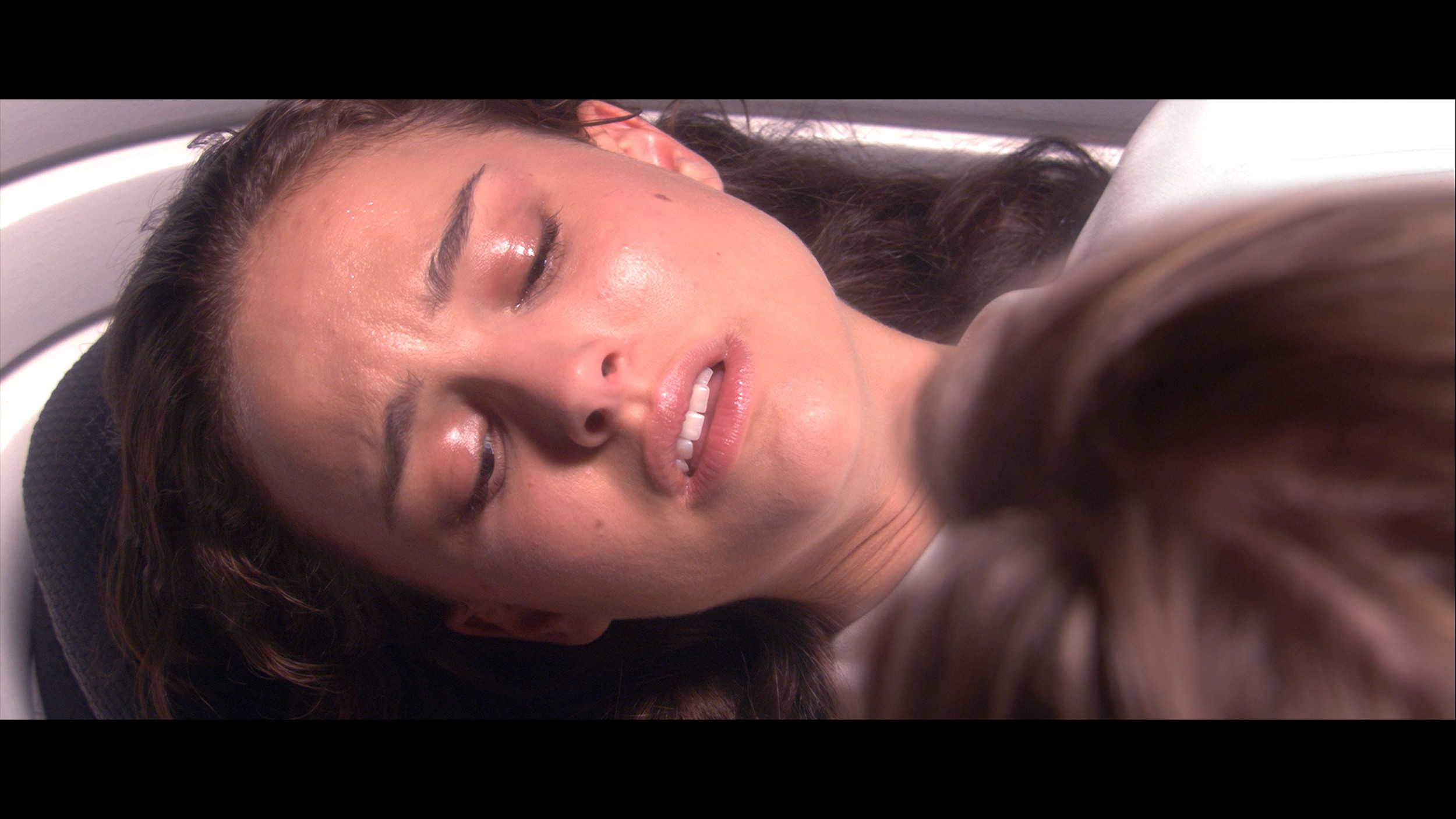
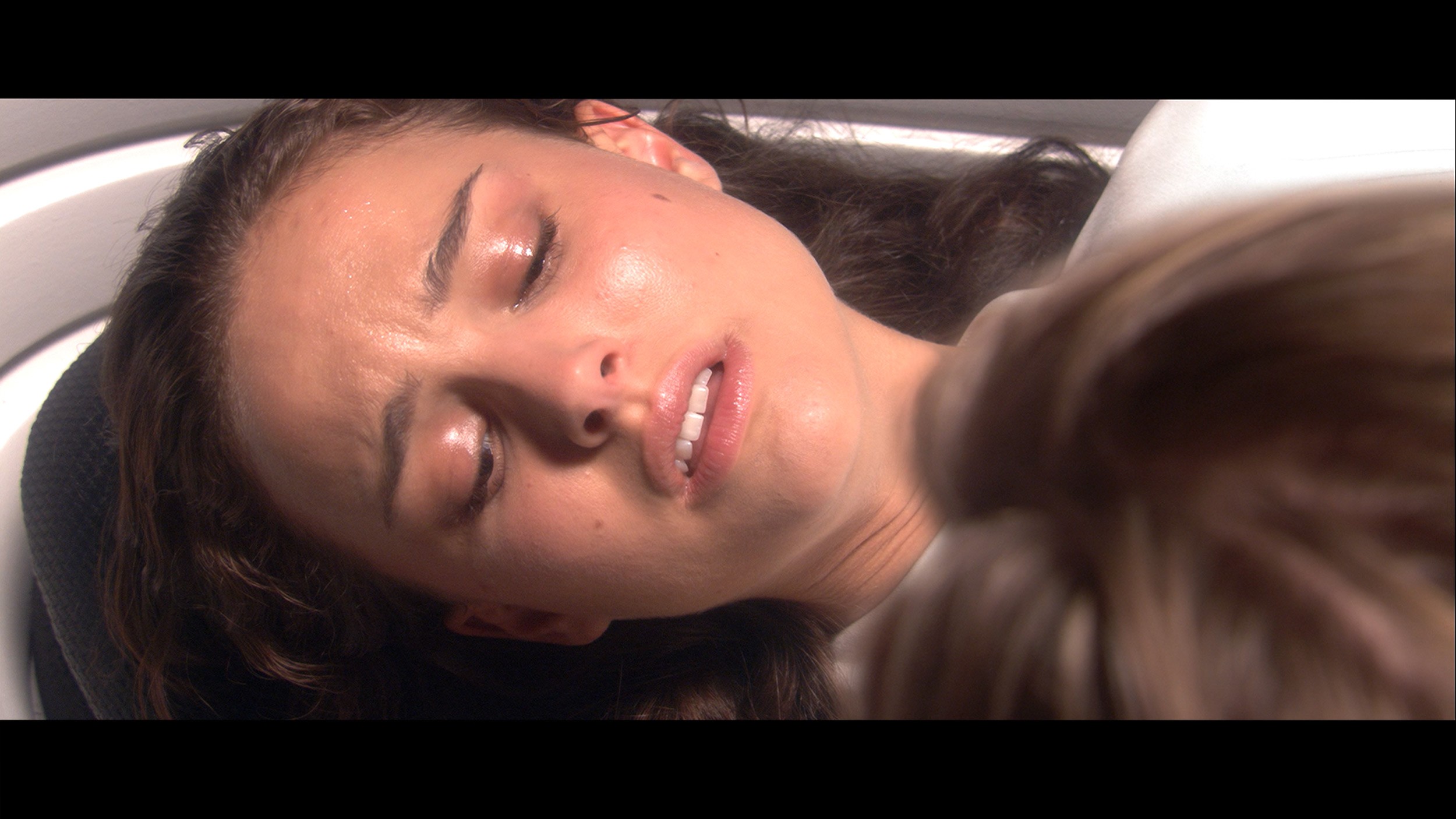
Factory Mode
After calibration
The Panasonic Z85A offers many picture modes, but the Filmmaker mode definitely stands out from the rest. It is rare for a television to be so well-tuned straight out of the box, and the unit we had the opportunity to test really impressed us positively.
However, there were some minor shortcomings. In the SDR signal, we noticed a slight deficiency in red and blue colors, which made the image have a cooler shade than it should. This is particularly evident in the comparative photo. Conversely, in 4K HDR materials, the situation was the opposite – the excess of red made the image seem warmer than the creators intended. In terms of brightness characteristics (gamma) and maintaining the appropriate EOTF curve, it is hard to find fault. There are some minor deviations, but they are so minimal that the average viewer is unlikely to notice them.
It is also worth emphasizing that our observations pertain to a specific unit of the television. Two identical models can differ from each other due to natural production variations. Nevertheless, the unit we had in hand is really solid and deserves praise. Now it's time for our calibration – we'll see if we can squeeze even more from this screen!
The novelty in TCL televisions for 2025 is the long-awaited Filmmaker mode, which until now could be found in most competitive brands. This is great news because this mode is considered the most faithful to the original vision of the creators and is often recommended by enthusiasts of good picture quality. Unfortunately – as is often the case – the mere presence of this mode does not guarantee perfection. The Filmmaker mode in the TCL C7K is not free from flaws. One could point out the incorrect white balance, particularly the slight dominance of blue, which led to cool, somewhat grayish skin tones. But that was not the biggest problem. The main complaint was excessive brightness exposure, which is clearly visible in the gamma and EOTF charts. The image was simply too bright, at times almost blown out, which affected not only the depth of scenes but also the overall viewing experience. Some details were simply lost, and the whole image looked as if someone had slightly overdone the brightness slider. As always – we decided to see what could be squeezed out of this after calibration. And that’s when things started to get really interesting…
Color reproduction after calibration
9.4/10
7.5/10

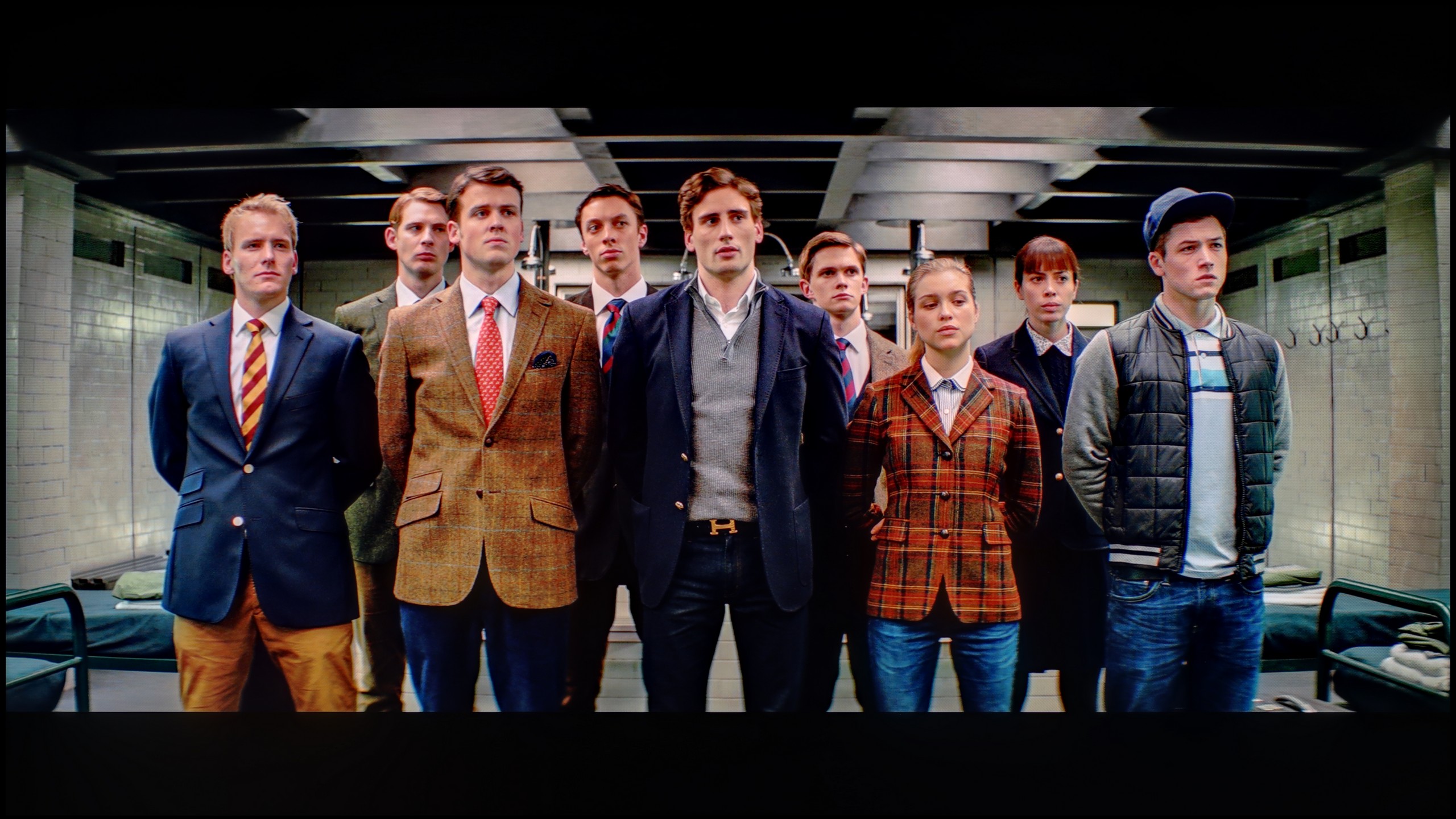


The Panasonic Z85A offers truly wide possibilities when it comes to image settings, so we enthusiastically set about calibration. Although we mainly focused on white balance correction, the final effect exceeded our expectations. Both HD and 4K HDR content now present nearly perfect color reproduction, with minimal errors that are difficult to catch with the naked eye. Well-calibrated televisions are rare, and we must admit – it is truly gratifying. Although gamma and EOTF curve did not require drastic adjustments, we managed to further stabilize their characteristics across the entire brightness scale. After calibration, the Panasonic Z85A is a true gem for home cinema enthusiasts. The image is precise, colors are natural, and every scene looks exactly as the director intended.
After calibration, the TCL C7K showed itself in a really good light, especially when it comes to SDR content. We managed to tune the white balance, color gamut, and brightness characteristics so precisely that color errors on the ColorChecker palette dropped below a value of 2. For the uninitiated – this is almost a perfect result, which means that the image is very close to what the creators intended. Unfortunately, it looked worse with 4K HDR content. Although we were able to slightly calm the white balance and correct its previous errors, it is still evident that the television has some "MiniLED traits," especially in brightness management. When we checked how the C7K handles the EOTF curve on actual film scenes, and not just on synthetic test patterns, it turned out that the screen still tends to slightly brighten the entire image. This affects the overall experience – black loses some depth, and the image becomes less contrastive than it should be. Despite these minor shortcomings in HDR content, the overall reception of materials – especially in SDR – is really very good. After calibration, the C7K can display an image that can successfully compete with much more expensive models. Good color tuning, natural skin tones, and pleasant brightness make movie sessions and everyday content viewing more than satisfactory.
Smoothness of tonal transitions
7.5/10
8.6/10

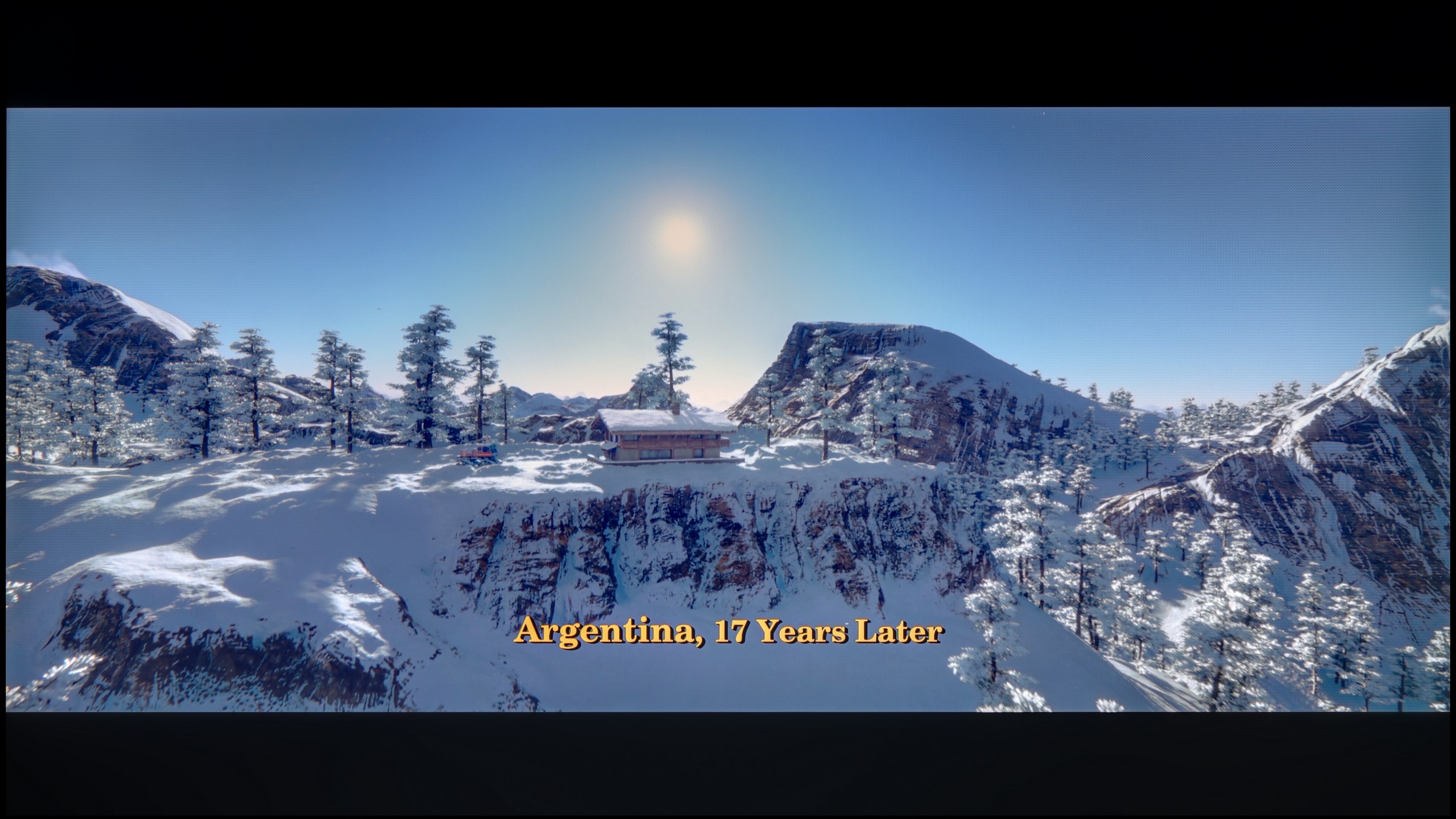



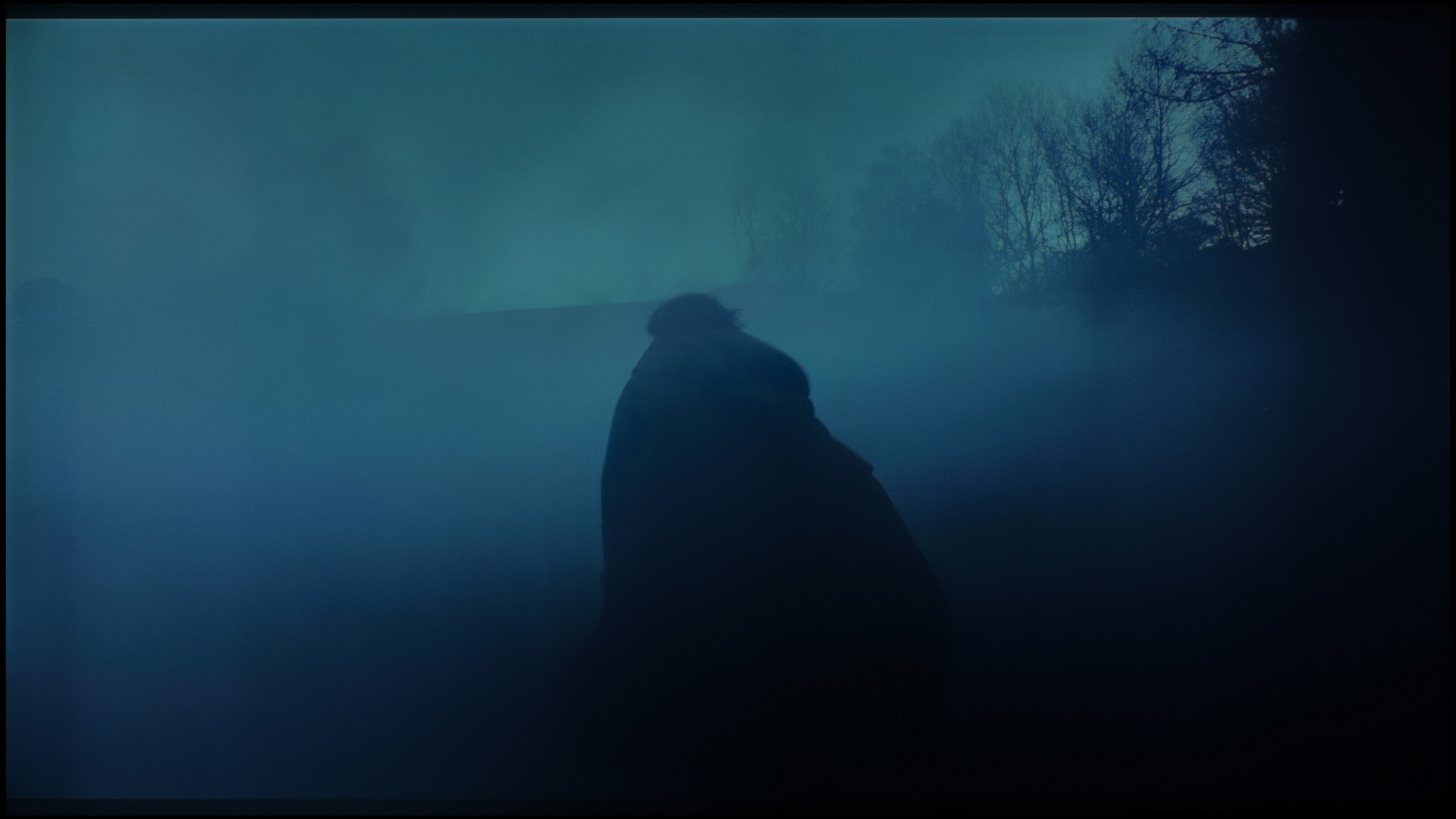

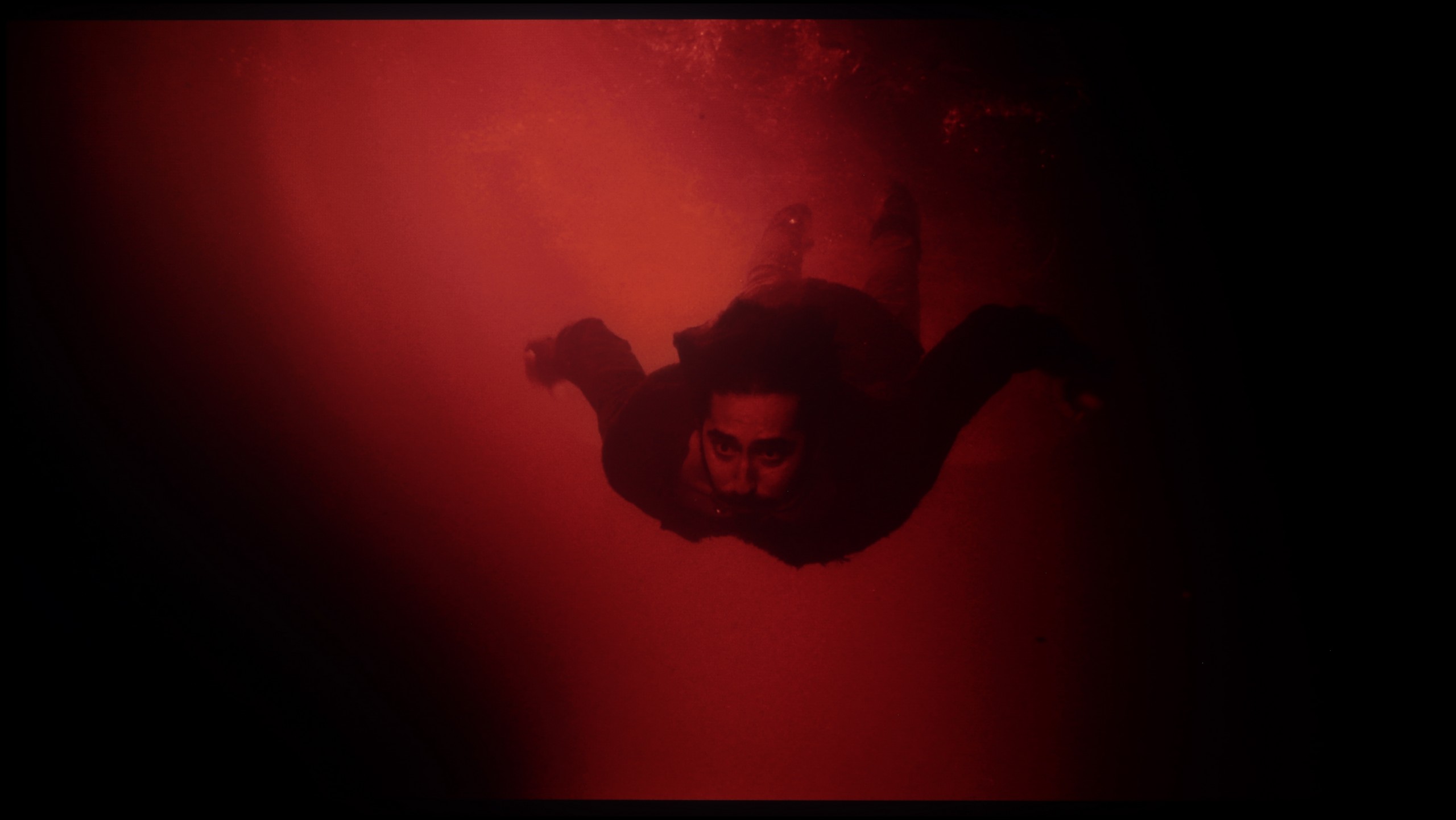




The Panasonic Z85A handles tonal transitions very well. Colors blend naturally without noticeable disruptions or visible bands. However, in brighter scenes, such as the opening sequence in the Kingsman film, slight imperfections can be seen. This is typical for WOLED panels, which have their limitations compared to Samsung Display's QD-OLED designs due to the use of white sub-pixels. The differences are not colossal, but a seasoned eye will catch them, especially in more demanding scenes with subtle color gradients. Despite these minor reservations, the Z85A presents a level that will satisfy the overwhelming majority of users. The tonal transitions are smooth, and the image remains consistent even in complex scenes. This is a solid result that will rarely be a hindrance during everyday viewing of movies or series.
TCL C7K handles color gradation very well – in most tested scenes, the tonal transitions were smooth, and the colors blended together without visible outlines or an artificial “blots” effect. In everyday use, it’s hard to find anything to complain about – the image looks natural, without irritating transitions or digital artifacts. Certain limitations only appear in very dark tones – especially in a heavily muted gray palette, where the television may struggle to reproduce the perfect gradation. But that’s absolutely understandable, as even many significantly more expensive models in this range simply give up. Fortunately, these situations are rare and do not significantly affect the overall perception.
Image scaling and smoothness of tonal transitions
7.4/10
5.5/10
Smooth transition function

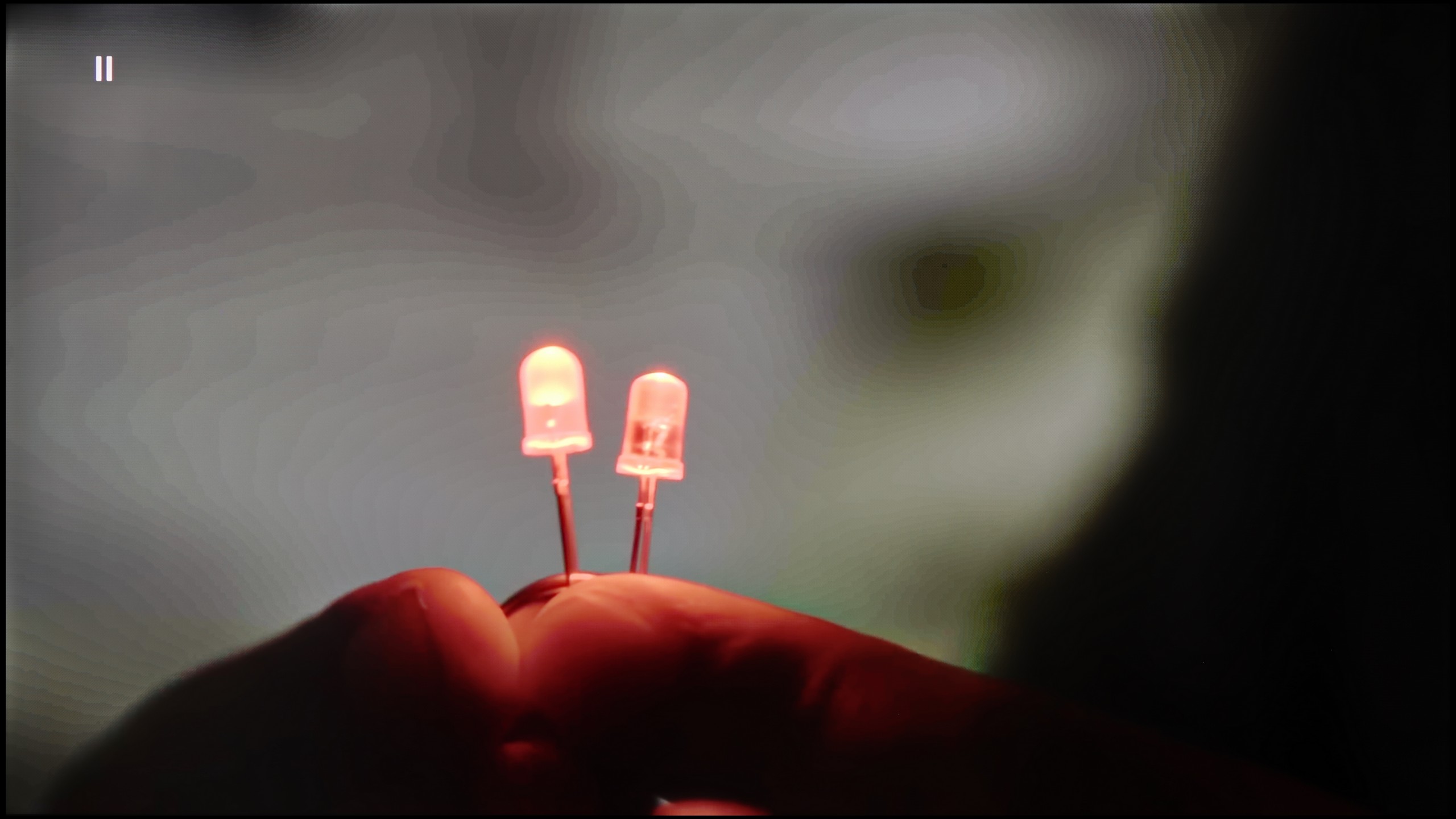
Image without overscan on the SD signal


Now that we know how the Panasonic Z85A handles tonal transitions in 4K materials, it's time to look at its "Gradation Smoothing" feature. It works, but unfortunately not entirely effectively. Regardless of the selected value – whether low, medium, or high – we were unable to achieve perfectly smooth tonal transitions in our test sequence. We recommend setting this feature to an intermediate level. While it may slightly blur fine details, it at least avoids the problem of losing film grain, which can be crucial for many viewers when watching classic productions.
When it comes to image scaling, the television performs quite well. It is evident that the image is slightly sharpened, and thin lines can sometimes appear somewhat jagged. However, this is standard in most televisions and fortunately, it can be adjusted using the sharpness slider. This gives us full control – we can achieve a more plastic, blurred image or a clearer one, though more "harsh" and artificially sharp. It all depends on the user’s preferences and the type of content we are watching. Overall, the scaling is at a solid level and should satisfy most users who are using lower resolution materials.
TCL C7K features a function that, according to the manufacturer, is supposed to smooth out unwanted color transitions – something like a rescue for less successful tonal changes. It's called "Gradual Smoothing" and... well, it sounds ambitious, but in practice, it works very poorly. Regardless of whether we set it to low or high, the difference is minimal. Worse still – the function can cut out elements from the image that should remain. Fortunately, film grain remains untouched, so at least it doesn't smooth everything indiscriminately, but still – it's better to just turn this option off.
When it comes to scaling lower-resolution content, it's already better. SD and HD materials look quite decent, although sometimes we felt that the image loses sharpness and becomes too soft – as if something took away its clarity. Fortunately, with very low sources (e.g., 576p), there was no overscan effect, meaning the image was not artificially cropped – everything fit on the screen as it should.
Blur and motion smoothness
8.5/10
8.1/10

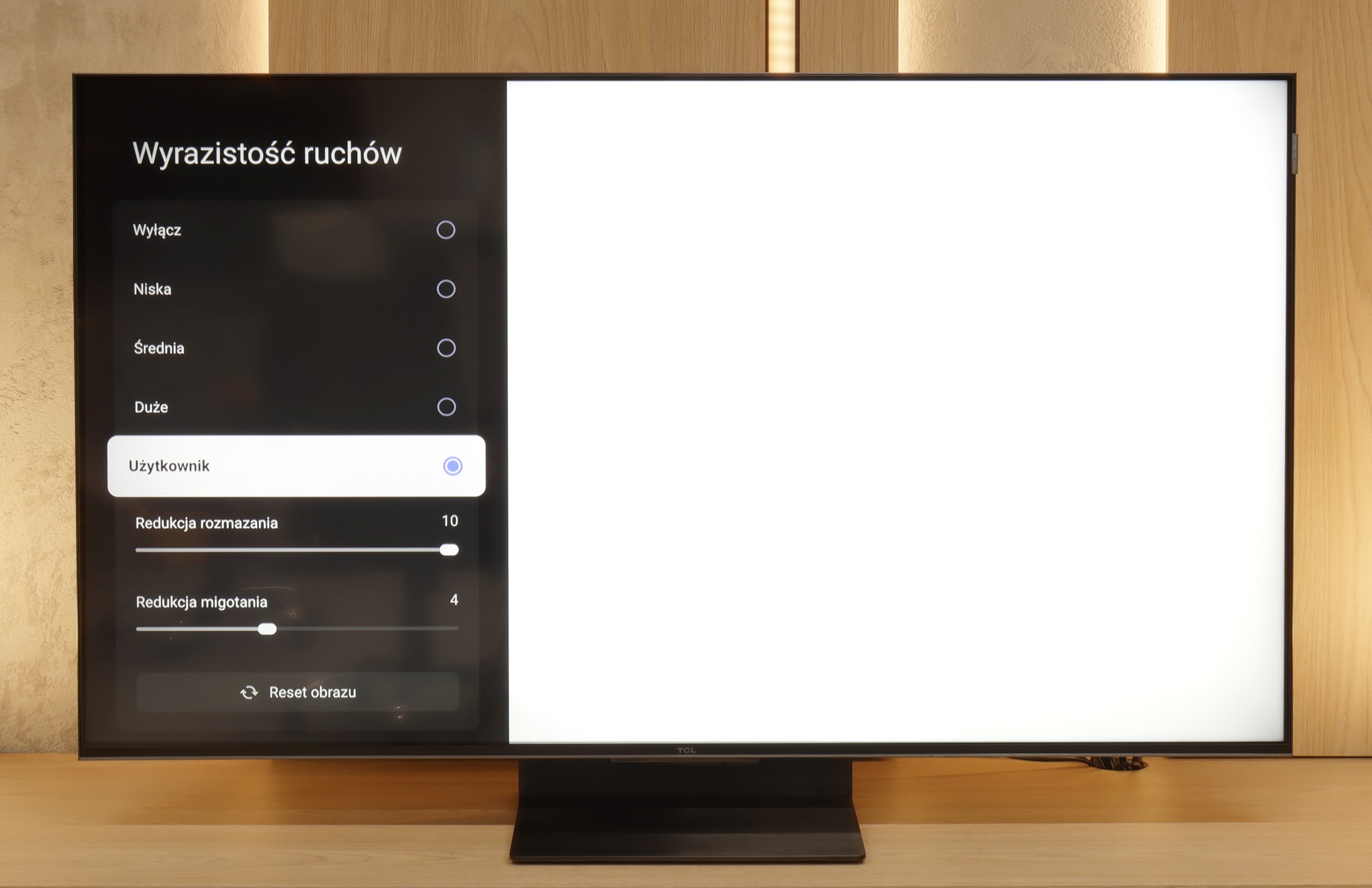
Blur (native resolution, maximum refresh rate):





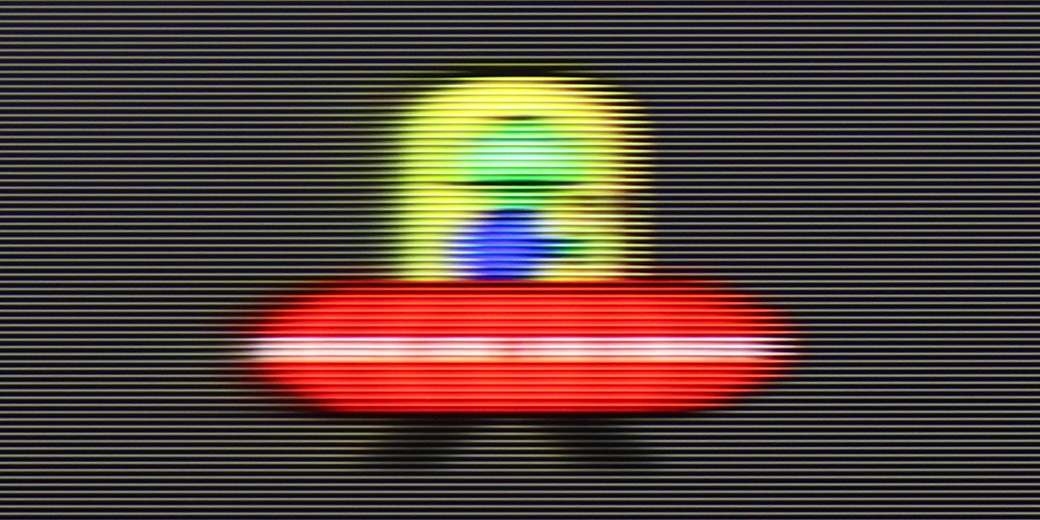
Blur (BFI function enabled):
Image flickers in this mode



Smużenie ():
Smużenie (4K@144Hz):



The Panasonic Z85A has a 120 Hz panel, which will surely please both gamers and sports fans. Sure, it's not 144 Hz like some gaming TVs, but in practice, the difference is really hard to notice. In games, the image is stable and clear, and during fast action, there's no sign of any motion blur. The same goes for sports – a quick run by a soccer player or a dynamic car maneuver looks smooth and natural. The TV also has an "Intelligent Frame Creation" feature, which is a motion smoother. There are two sliders – one for reducing motion blur and the other for motion smoothness. With these, you can adjust the picture to your personal preferences – whether you prefer a more cinematic effect with gentle transitions between frames or a maximally smooth image perfect for watching sports.
The TCL C7K handles motion fluency really well. The panel used in it offers a refresh rate of 144 Hz, which in itself suggests that this TV is something more than just an ordinary "60 Hz" panel. Moreover, if we connect the C7K to a computer and set the resolution to Full HD. But we'll write more about that in the paragraph about gamers and PC collaboration. Back to everyday use – both sports and movies look very good here. Thanks to the fast panel and well-functioning motion smoother, the C7K is great for watching matches, but also for movie screenings. In the menu, we find two sliders – blur reduction and flicker reduction – which allow you to tailor the smoothness effect to your own preferences. At lower settings, we get a more cinematic effect, with a slight stutter in motion. At higher settings – the image becomes more theatrical, smooth to the point of exaggeration. Everyone can set it up according to their liking.
Console compatibility and gaming features
10/10
9.8/10
- ALLM
- VRR
- VRR range40 - 120Hz48 - 240Hz
- Dolby Vision Game Mode
- Correct implementation of HGIG
- 1080p@120Hz
- 1440p@120Hz
- 4K@120Hz
- Game bar

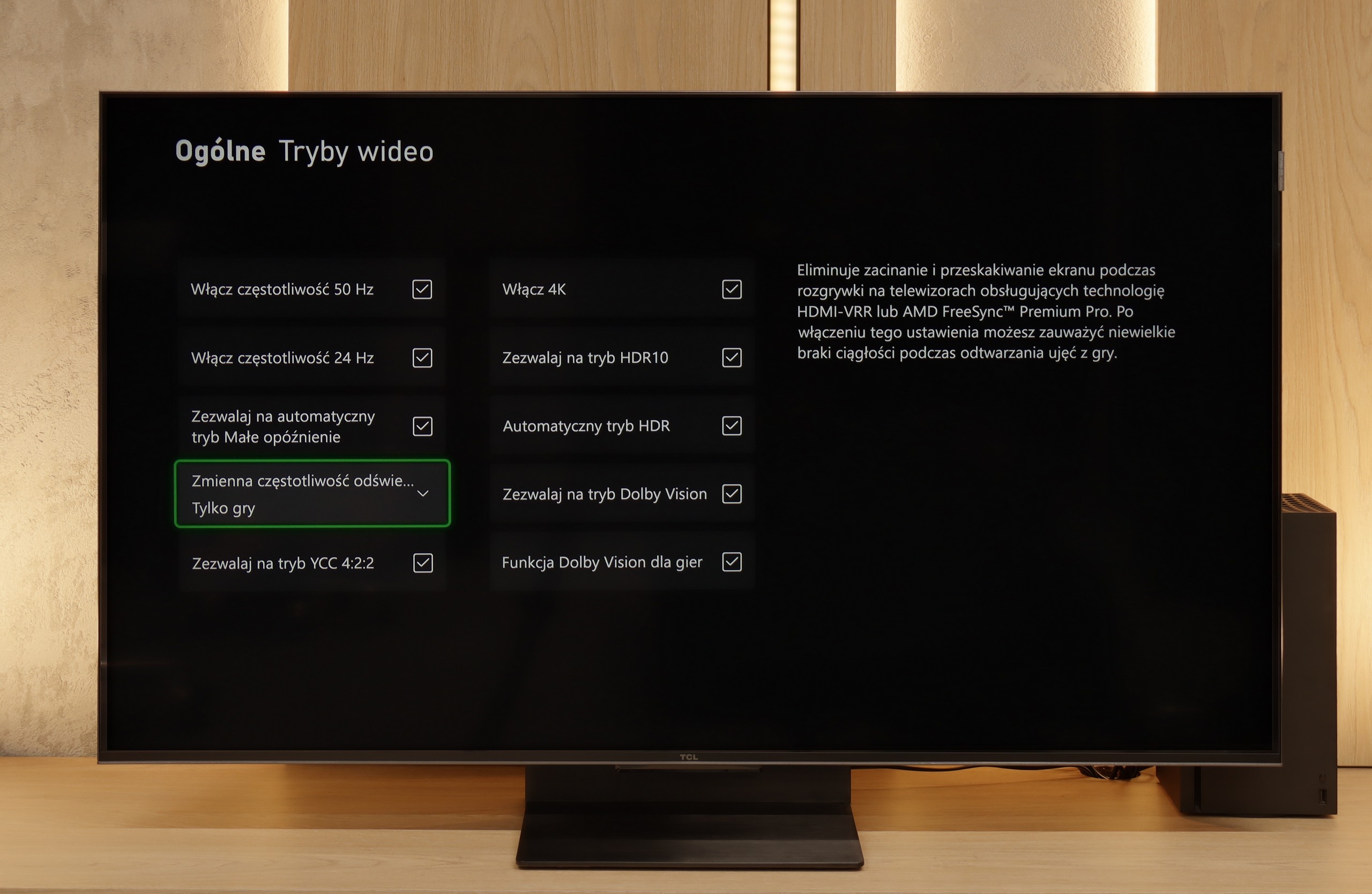

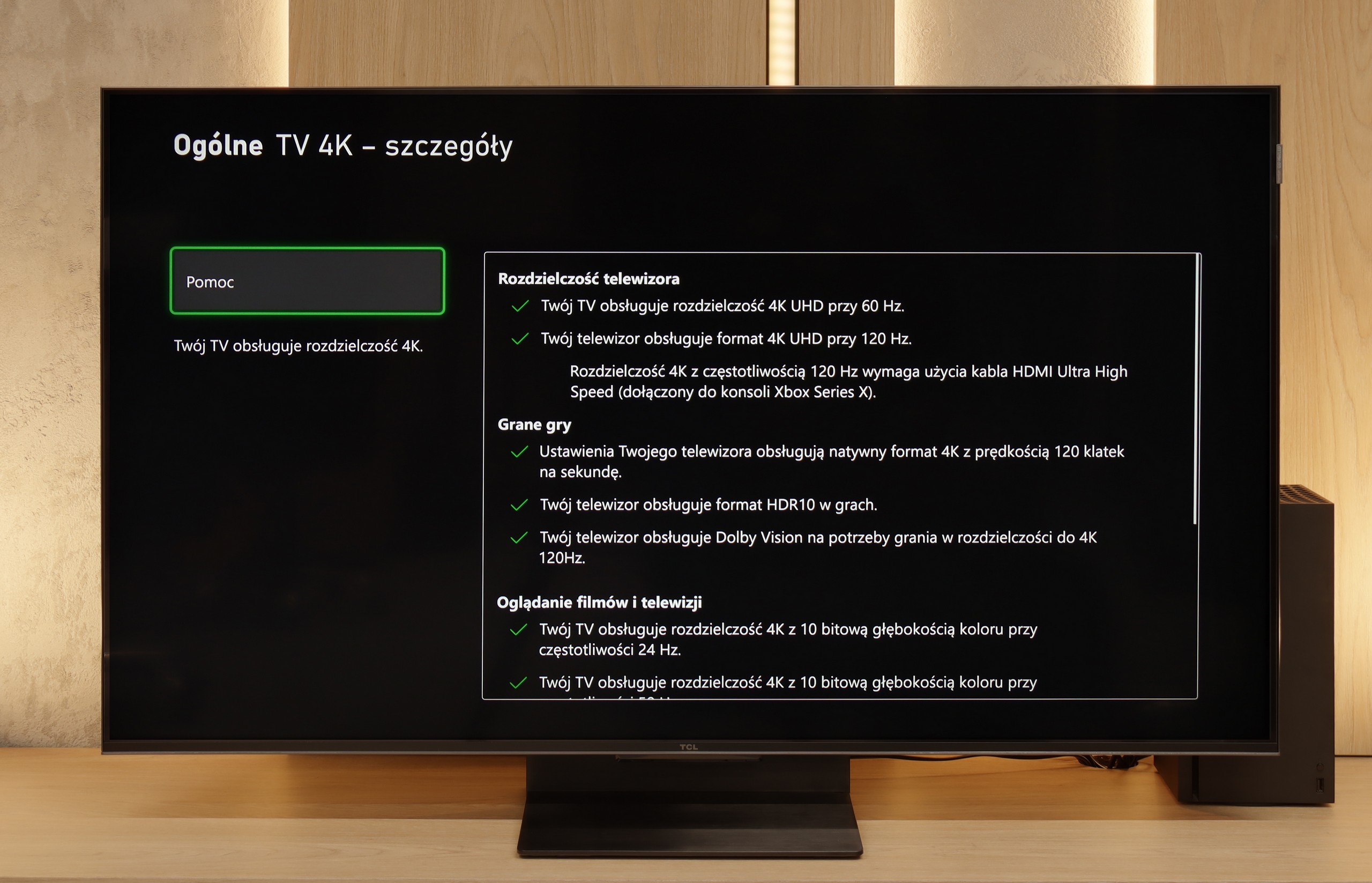

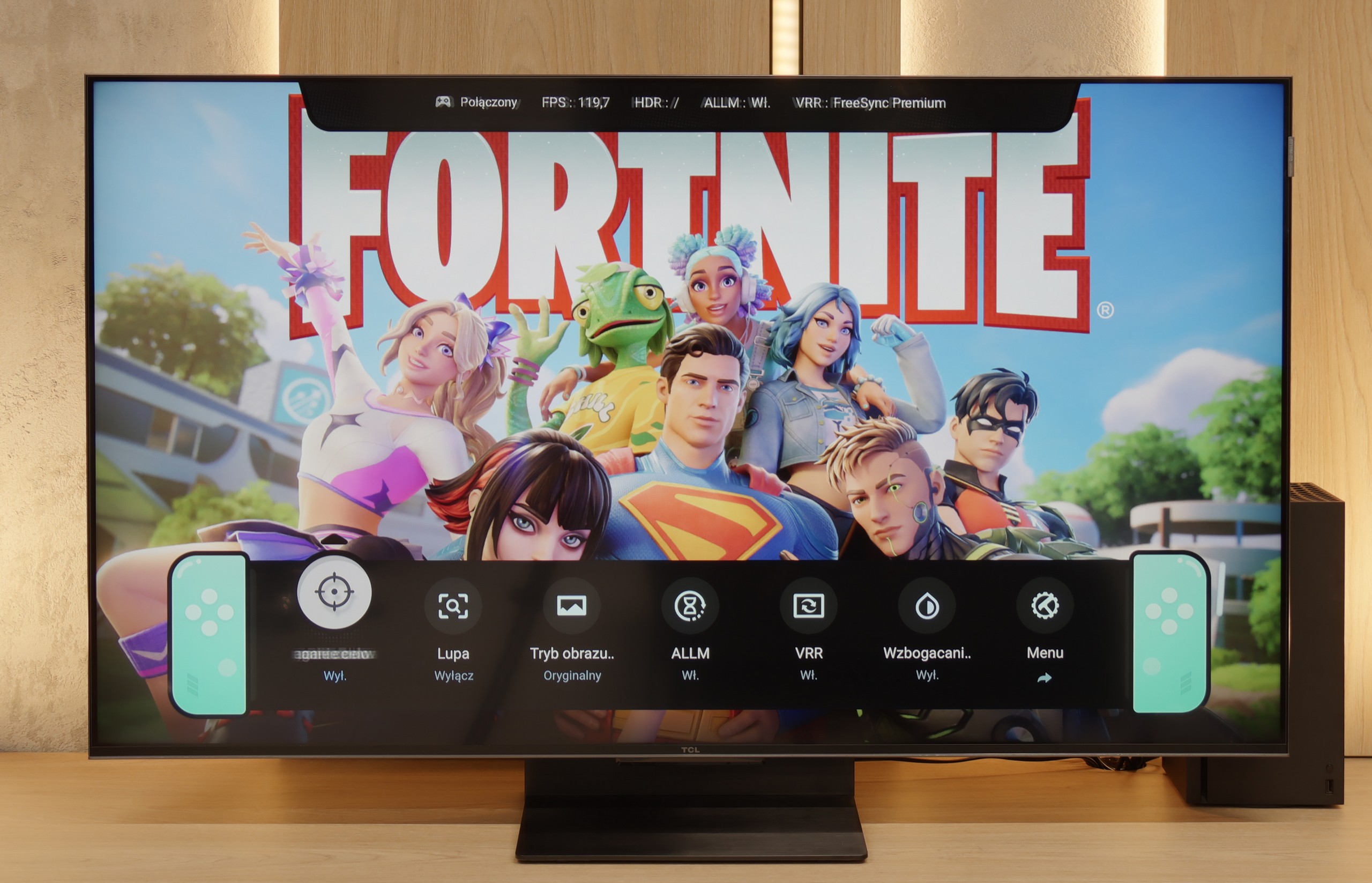

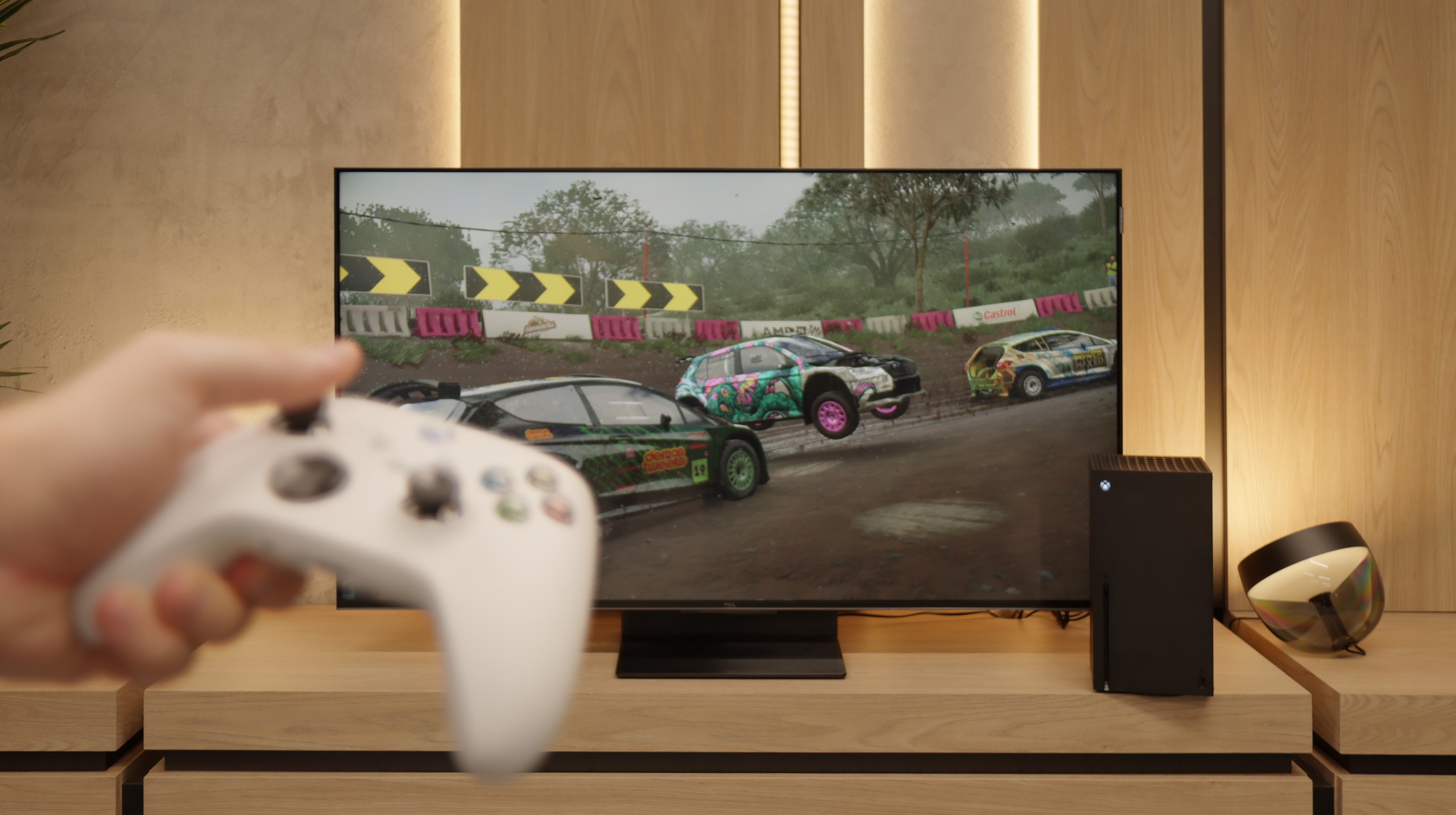
Panasonic is mainly associated with home cinema televisions, but the Z85A shows that it can also enter the gaming world with a really strong punch. This is equipment that can easily be called a gaming beast - it has everything needed for comfortable gameplay.
Even though we only have two HDMI 2.1 ports, both operate at full bandwidth, so we can easily connect both a next-gen console and a gaming PC. All key features are supported: ALLM automatically switches the TV to game mode, VRR ensures smooth images without stuttering and tearing, and with properly implemented HGIG and Dolby Vision, HDR games look really good - colors are vivid, details clear, and dark scenes readable. There is also a Game Bar in the form of a clear, circular menu. It may not look as impressive as with the competition, but it is intuitive and contains all the most important settings that we would like to have at hand during gaming.
In summary - the Panasonic Z85A is equipment that really surprises with its gaming capabilities. It is a television where both console gamers and PC gamers will feel at home. It's smooth, dynamic, and simply good.
TCL C7K is a television that on paper looks like the dream equipment for gamers – and most importantly, it holds up well in practice. First, the good news: we have two full-bandwidth HDMI 2.1 ports, so we can easily connect both a console and a computer, taking full advantage of their capabilities. The panel itself supports a refresh rate of 144 Hz, which provides a significant advantage in dynamic games. Additionally, it comes with a full suite of gaming features: VRR (variable refresh rate), ALLM (automatic low latency mode), and support for Dolby Vision in games. There's also an HGiG mode that allows for HDR effects consistent with the creators' intentions. GameBar, which is an informative bar for the gamer. It operates quickly, looks clear (like the Nintendo console👌), and shows what’s most important: the current frame count, VRR status, and even HDR parameters.
Input lag
10/10
9.6/10
SDR
HDR
Dolby Vision
Since the Panasonic Z85A was also designed with gamers in mind, the input lag had to be fine-tuned. And indeed – the results are really great. At 120 Hz, the lag is only 5 ms, and at 60 Hz, it's 13 ms. These are values that will satisfy even the most demanding gamers, whether we're talking about dynamic shooters or precise fighting games. The reactions to our controller movements are practically instantaneous, and the gameplay is smooth and responsive. Importantly, the Dolby Vision mode also works flawlessly here. Just a few years ago, using Dolby Vision in games often came with high input lag, but in the Z85A, this problem has been effectively eliminated.
When it comes to delays, the C7K gives no reason to complain. In games at 120 Hz, the input lag is around 10 ms, which means the television responds really quickly. Interestingly, even in Dolby Vision mode, the result is very similar, which is not always the standard. Good job, TCL. At 60 Hz, the lag naturally increases a bit, but that's completely normal and applies to virtually every television with a refresh rate of 120 Hz or higher. The most important thing is that everything still operates smoothly and there’s no feeling that something is unresponsive to our actions.
Compatibility with PC
7.6/10
8.4/10

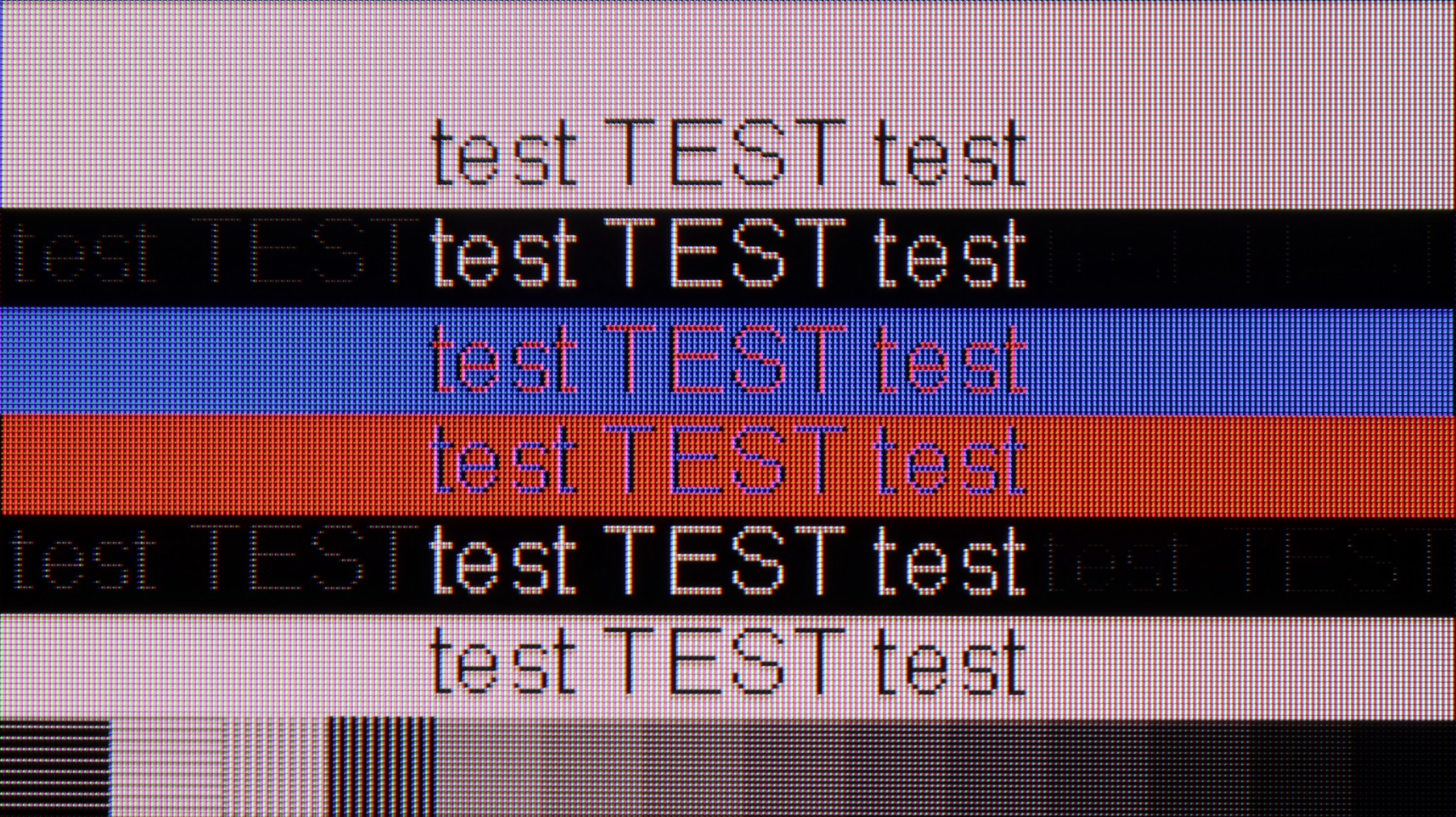
Using the Panasonic Z85A as a computer monitor performs really well. Text is readable and clear, making web browsing or working with documents not much of a problem. However, one has to keep in mind certain limitations of the WOLED panel – the characteristic way of displaying fonts may be bothersome for more demanding users, especially those who spend long hours working with text. In terms of gaming on PC, the TV performs as well as with a console. Low input lag, 120 Hz refresh rate, and proper implementation of G-Sync and FreeSync ensure smooth and responsive image without annoying stutters or tearing.
If we intend to connect the C7K to a computer – especially for gaming – there’s really a lot to play for. We have 4K at 144 Hz, which sounds great on its own, but if we lower the resolution, the TV can display even 280 Hz. In e-sports, where every fraction of a second counts, this really makes a difference. Additionally, it supports G-Sync and FreeSync, so no matter what graphics card we have – the image will be smooth, without any stuttering or tearing.
However, if we plan to place the C7K on a desk and use it like a monitor, it’s a bit less "rosy." Yes, it supports chroma 4:4:4, so the fonts should be sharp, but with very dark letters, there’s a slight blurriness and dimming of the edges. It's not something that immediately stands out while gaming or watching, but when working with text – it can be distracting. In everyday use – rather without concerns, but if we plan to place 50 inches a meter from our face, it’s worth keeping this in mind.
Viewing angles
7.4/10
3/10
The viewing angles on the Panasonic Z85A are really good – after all, it's OLED. Whether we are looking at the screen straight on or at a steep angle, the colors remain vibrant, and the contrast hardly loses quality. Of course, the Z85A falls a bit short compared to TVs with MLA micro-lens technology or Samsung's QD-OLED panels, which currently set the highest standard in this regard. However, the differences are subtle enough that most users won't notice them during regular viewing.
There are no surprises here – the C7K has classic viewing angles for a VA panel. That is: sitting directly in front – it’s great. The colors look good, the contrast is strong, everything is in place. But just slightly shifting to the side begins to worsen the experience – the image loses saturation, blacks turn gray, and the overall impression suffers a bit. So if we plan to watch together with several people or have a couch that occupies half the living room – it’s worth seating everyone more centrally. You can watch from the side, but don’t expect miracles – it’s just a characteristic of VA panels.
TV efficiency during daytime
4.8/10
6.4/10

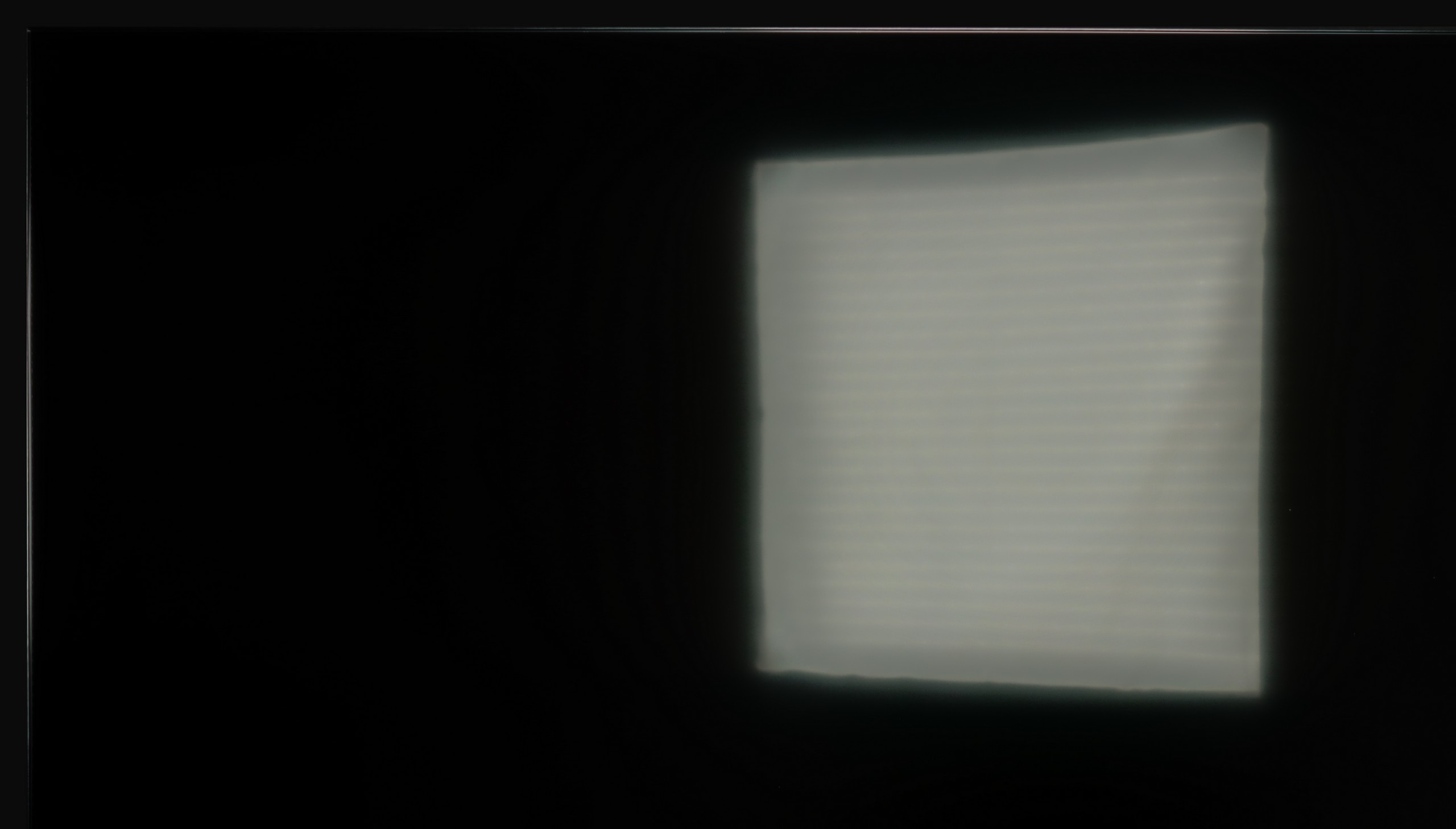


Matrix brightness
Average luminance SDR
TCL C7K / QM7K 55"-85": 529 cd/m2
Panasonic Z85A: 286 cd/m2
The Panasonic Z85A leaves something to be desired during the day. The panel, although silky, averages in suppressing reflections, which can be noticeable in bright rooms. The reflections are not overly prominent, but there is one catch – they take on a bluish tint. In some situations, especially in strong daylight, this can be slightly annoying and distract from the content on the screen. Additionally, the maximum brightness is just under 280 cd/m². That’s simply too little to comfortably watch television in a brightly lit room. If we plan to watch a movie in the middle of a sunny day, we will need to close the curtains to ensure the picture looks good.
Fortunately, the TCL C7K performs quite well in a bright room. The applied panel has a satin finish that effectively suppresses reflections, making it so that even on sunny days, we don’t have to worry about reflections from lamps or windows. Importantly, the colors maintain their intensity and do not wash out, as can happen with weaker matte panels. Regarding brightness itself, the average for content like YouTube or regular television reaches a little below 500 nits. It’s not a record-setting result— for example, the MQLED85 (C765) performs better in this regard. However, for everyday watching during the day, it should work without major issues, as long as we don’t plan to place it opposite a south-facing window without curtains.
Details about the matrix
Subpixel Structure:

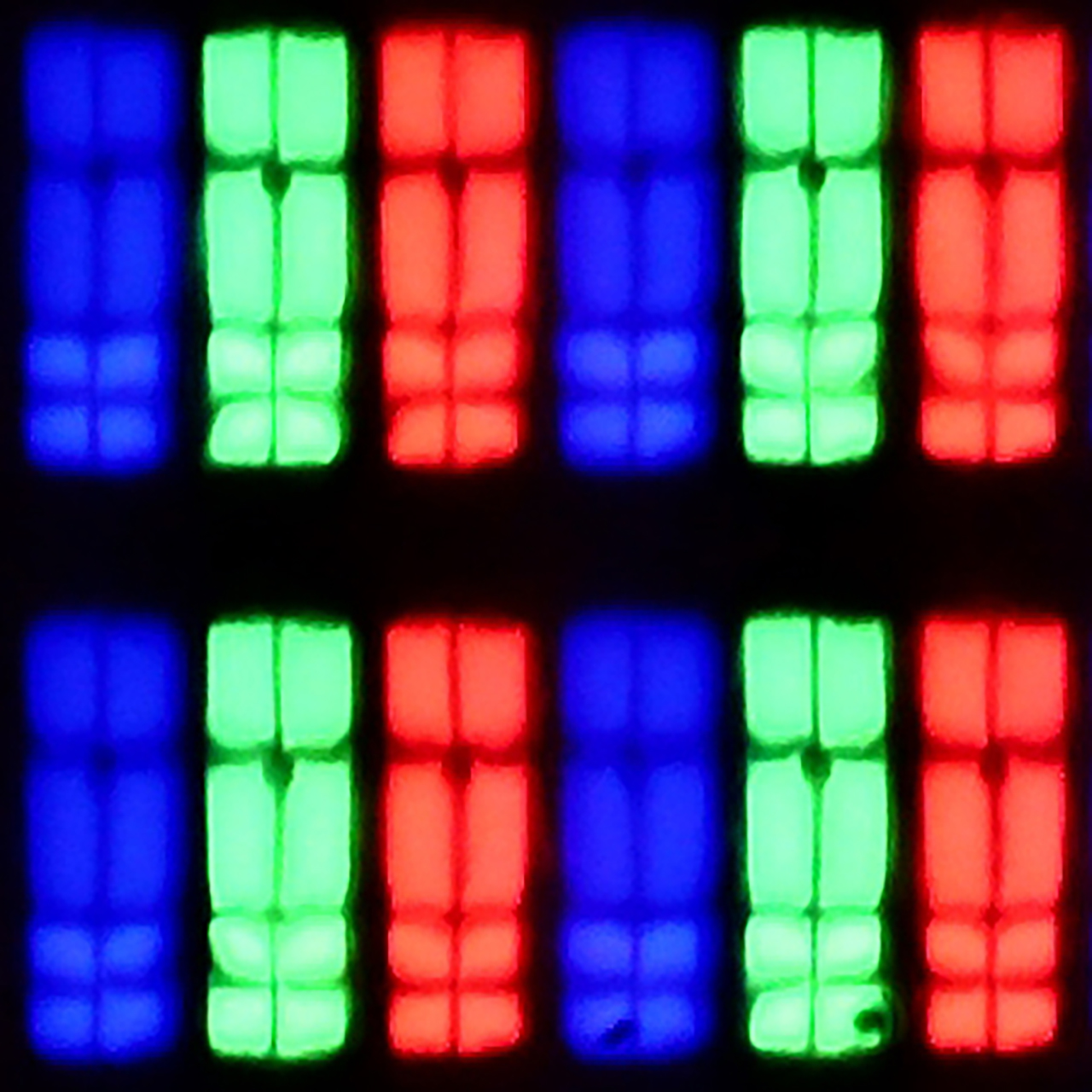
Panel uniformity and thermal imaging:

TV features
7/10
7.3/10
- HDMI inputs2 x HDMI 2.0, 2 x HDMI 2.1 48Gbps2 x HDMI 2.0, 2 x HDMI 2.1 48Gbps
- OutputsToslink (Optical audio), eARC (HDMI), ARC (HDMI), Mini-Jack (Headphones)Toslink (Optical audio), eARC (HDMI), ARC (HDMI)
- Network InterfacesWi-Fi 2.4GHz, Wi-Fi 5GHz, Ethernet (LAN) 100MbpsWi-Fi 2.4GHz, Wi-Fi 5GHz, Ethernet (LAN) 100Mbps
- TV receptionDVB-T, DVB-T2, DVB-S, DVB-S2, DVB-CDVB-T, DVB-T2, DVB-S, DVB-S2, DVB-C
Classic features:
- Recording to USB (terrestrial TV)
- Recording programming
- Picture in Picture (PiP)
- RF remote control (no need to aim at the screen)
- Backlit remote control
- Teletext
- Audio only mode
- Bluetooth headphones support
- Simultaneous Bluetooth headphones & TV audio
Smart features:
- AirPlay
- Screen mirroring (Windows Miracast)
- Voice search
- Voice search in native language
- Ability to connect a keyboard and mouse


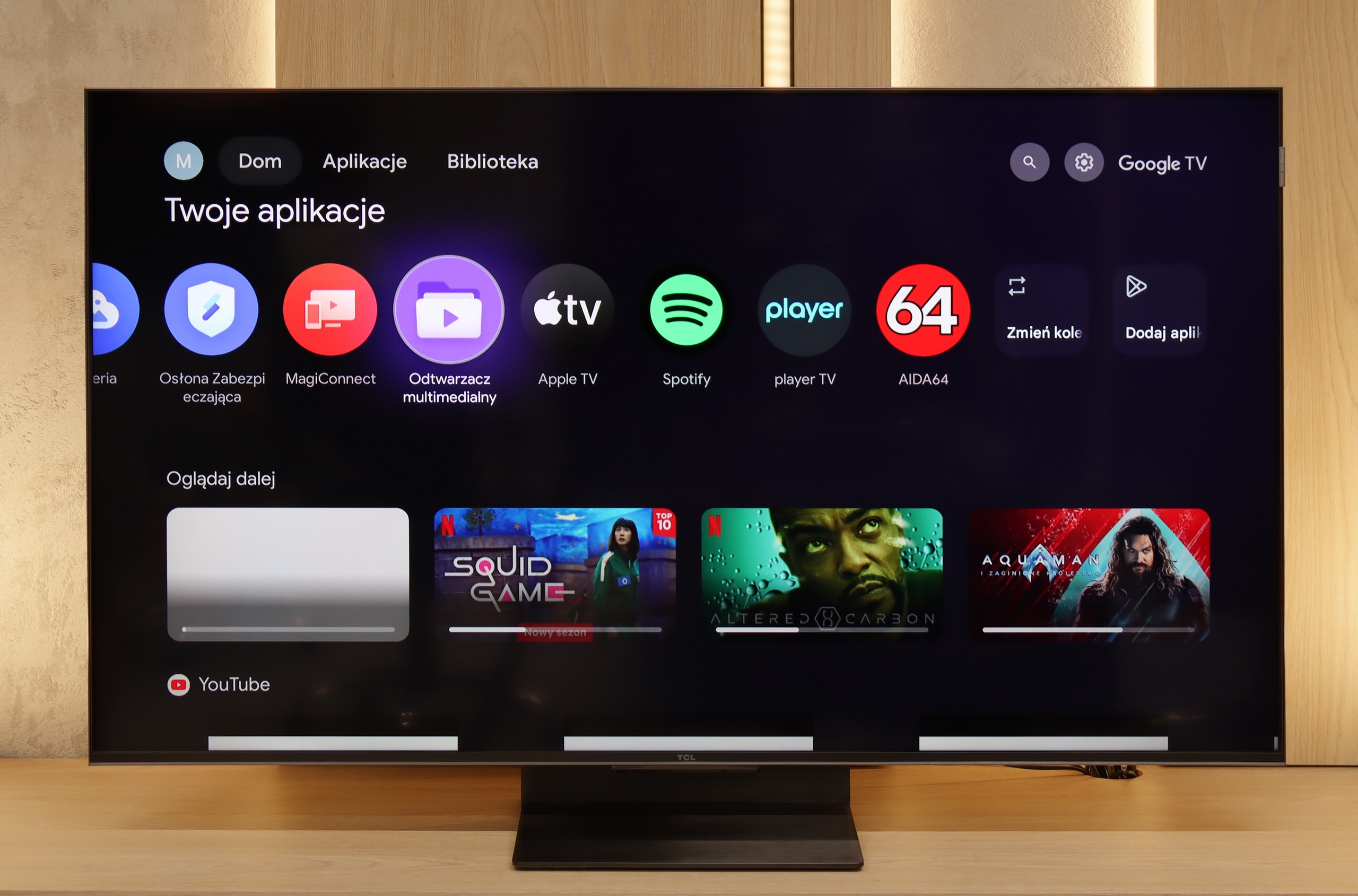
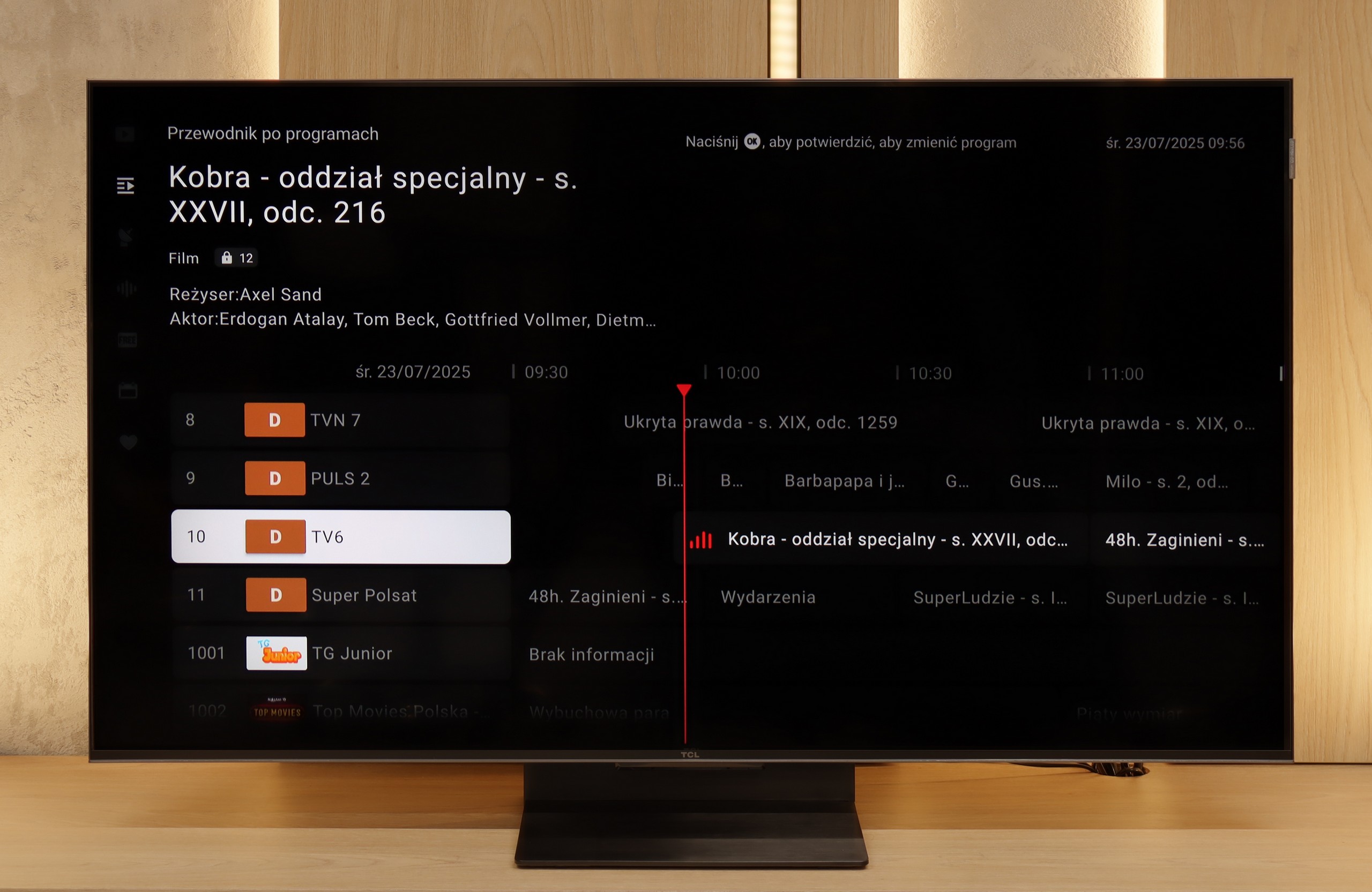
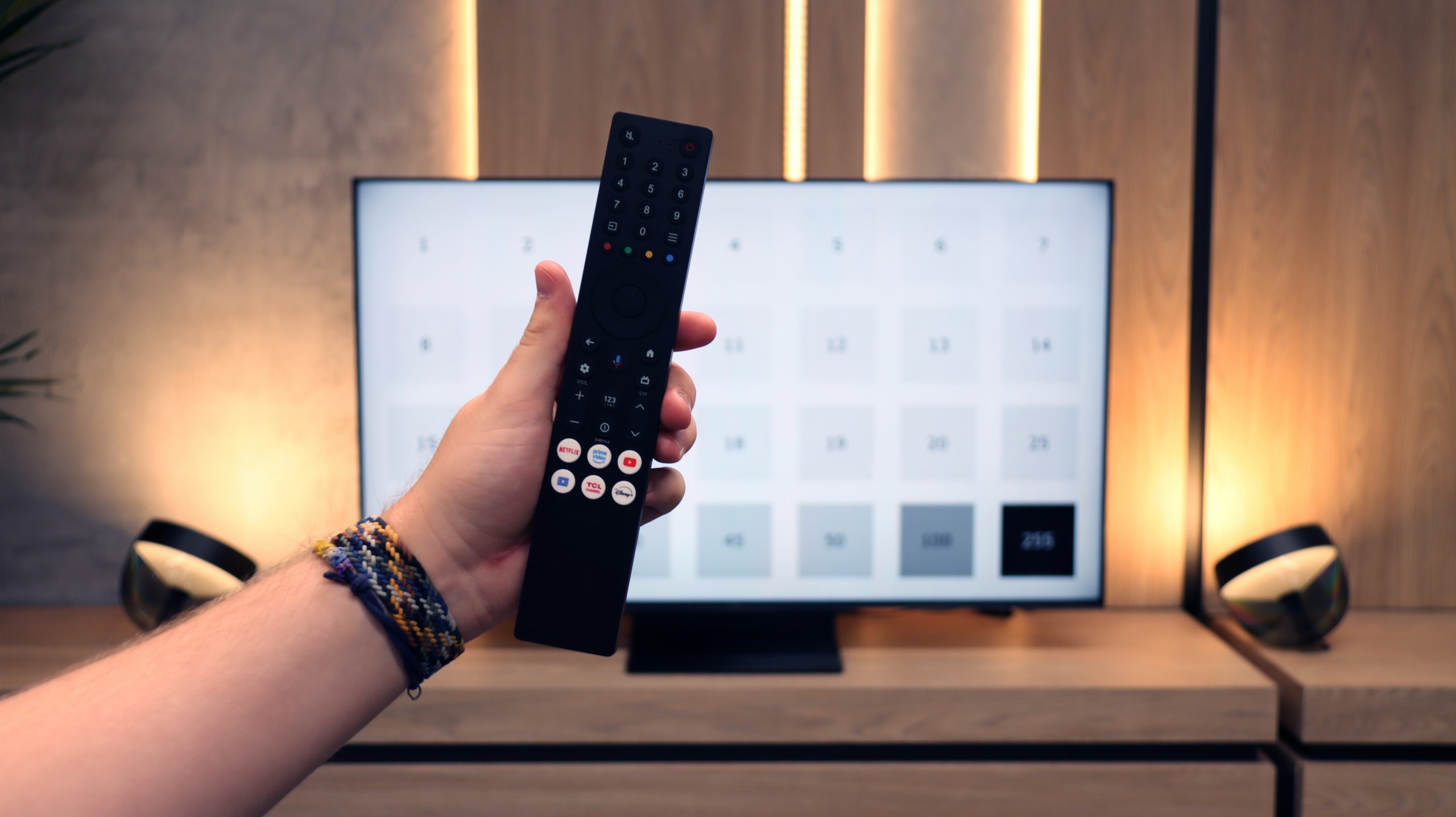
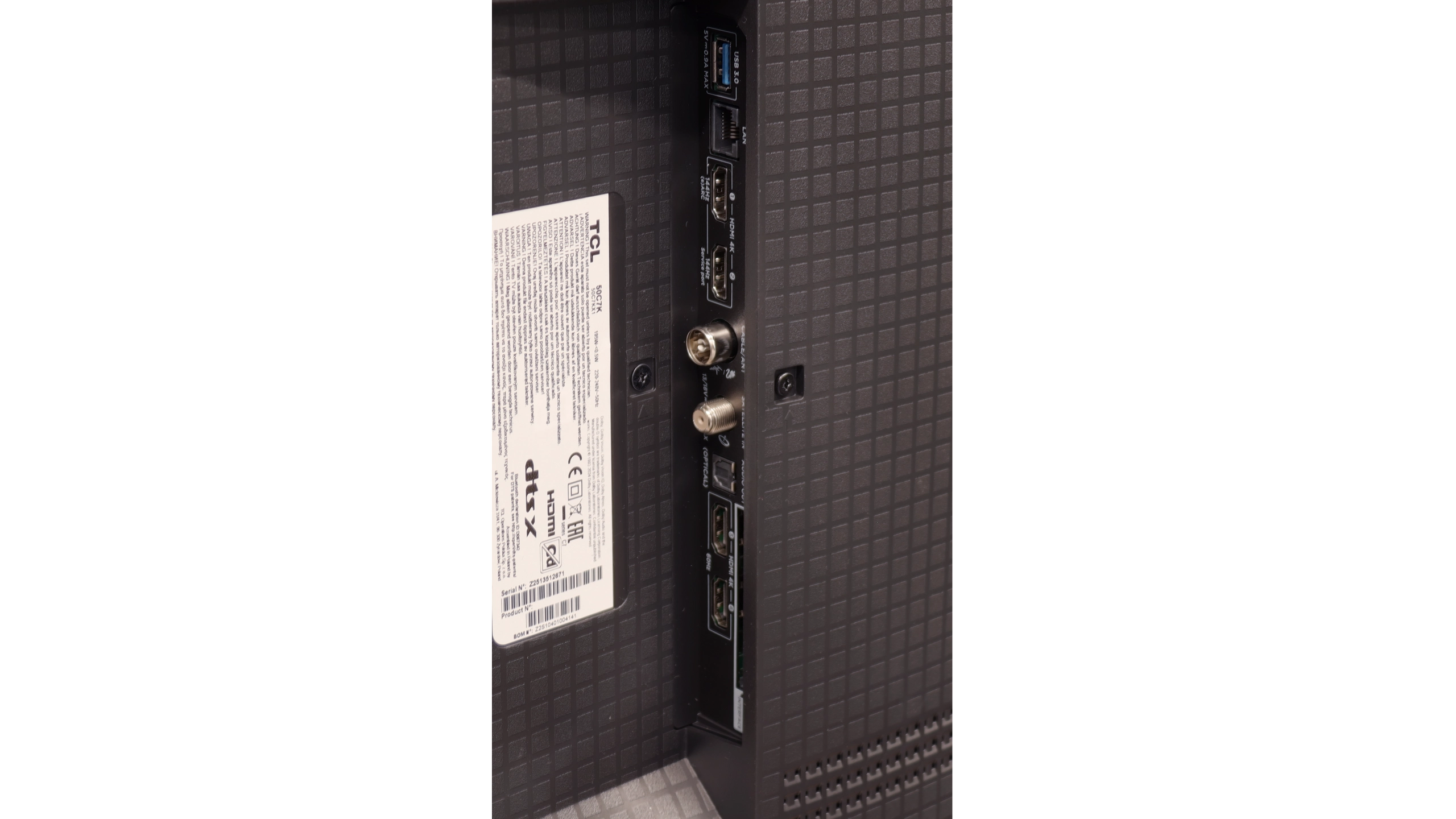
The operating system in the Panasonic Z85A is Amazon Fire TV, which is still a relatively new solution in the Polish market. Until now, we primarily associated it with portable smart devices, and now it is also coming to televisions – similar to the flagship model Z95A.
On the positive side, the system works smoothly and responsively. It is also quite intuitive, so navigation does not pose major problems. Unfortunately, when it comes to the availability of applications, it is somewhat worse. In the Amazon store, we can find icons for popular services such as SkyShowtime, Rakuten, or Viaplay, but... they cannot be downloaded. This is a significant drawback for those who use these platforms daily. Additionally, some functions are poorly translated, which means that in some places, you have to guess what they mean. However, we believe that these are just growing pains, and over time, these issues will be resolved – both in terms of translations and app availability.
When it comes to practical features, it is much better. The TV supports USB recording and the PiP (picture-in-picture) function. There is also support for AirPlay, which will certainly please users of Apple devices. We also have Bluetooth here, but unfortunately, we cannot connect headphones to it – it only works with keyboards or other control devices. Fortunately, you can connect headphones or a home theater system via cable, which solves this problem.
In summary – the Panasonic Z85A offers a solid set of practical features that will work well for everyday use. The Amazon Fire TV system is a step in the right direction, especially when compared to Panasonic's old system. However, at this moment, it is difficult to give it an unequivocal praise. There is potential, but the manufacturer still has a lot of work to do to ensure everything works as it should.
SmartTV: GoogleTV
The biggest strength of the TCL C7K in everyday use is undoubtedly the Google TV system. Thanks to it, we have access to an almost endless library of applications, including those more niche ones that are often unavailable on other platforms. The built-in Google Assistant understands Polish, so we can easily ask what is on TV, what the weather is like, and even issue a few voice commands to control the television. We also have to appreciate the presence of Chromecast and AirPlay, which work smoothly and make life easier.
Usability Features
On the downside, the classic features perform a bit worse. Of course, we will find the basics here – teletext, EPG, or the ability to connect headphones – but that's basically it. There is a lack of USB recording functionality and picture-in-picture (PiP) mode, which can still be found with the competition at times. It is also worth noting that Google TV in the TCL version can sometimes have oddly translated fragments of the menu or minor interface bugs. These are not things that hinder everyday use, but detail-oriented people might notice them.
Playing files from USB
3.1/10
9.2/10
Supported photo formats:
Maximum photo resolution:

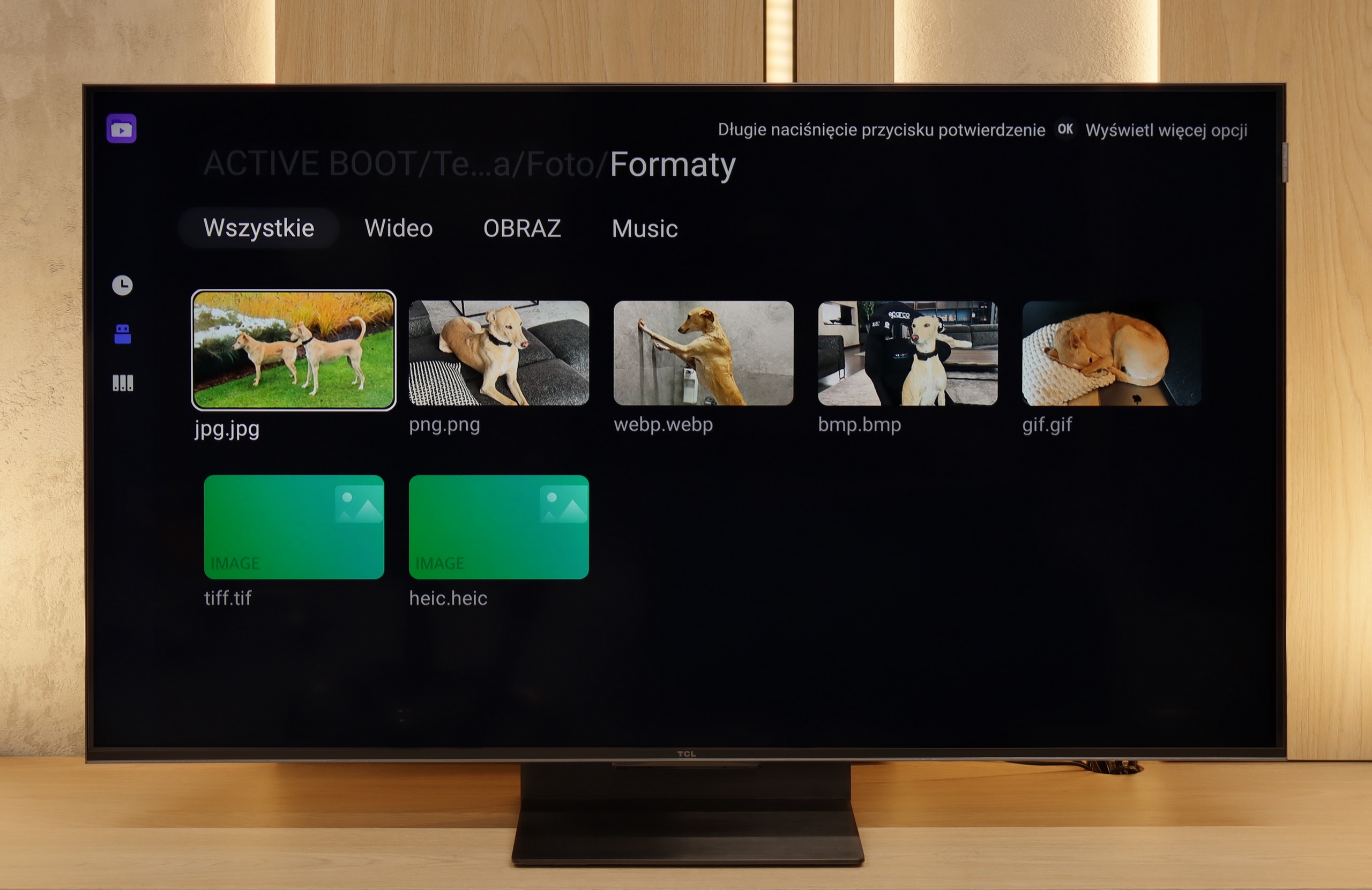
In terms of playing files from USB, the Panasonic Z85A performs rather mediocrely. The built-in media player does handle most popular video formats, but it has one significant drawback – it does not support external subtitles. So, if we have older movies on the disk or USB drive with separate subtitle files, we must reckon with the fact that the TV simply will not display them. This is a significant downside, especially for those who use their own media library instead of streaming services. Of course, this problem can be circumvented by using an external media player (e.g., through a console or Smart TV box), but it is an additional step that could be avoided if the built-in application were better developed.
The built-in file player in the TCL C7K performs really well. It supports most popular audio and video formats, so if we want to quickly load something from a USB drive and play it, there shouldn't be a problem. Of course, as is often the case, there can be some minor shortcomings – not every exotic codec will work (Apple's HEIC), not all subtitles will be perfectly synchronized (txt.). However, the biggest advantage of this television comes to the rescue, which is Google TV. Thanks to access to the Google Play Store, we can easily install an alternative player, such as VLC, and then no file will be a challenge for us.
Apps
5.7/10
9.6/10














































Sound
7.4/10
7.7/10
- Maximum volume--
- Dolby Digital Plus 7.1
- Dolby True HD 7.1
- Dolby Atmos in Dolby Digital Plus (JOC)
- Dolby Atmos in Dolby True HD
- DTS:X in DTS-HD MA
- DTS-HD Master Audio
In terms of sound, the Panasonic Z85A is pleasantly surprising. The TV delivers a pleasant and clear sound, and it can also generate a noticeable bass that adds depth to both movies and music. The spatial effect is also quite well reproduced, making watching movies or playing games more immersive. Unfortunately, there is one "but." The TV does not support the DTS:X format, which is quite popular among more advanced home theater systems. So if we plan to use this sound standard, it will be necessary to connect the audio equipment first to the amplifier or soundbar and only then to the TV.
In larger versions of the C7K (from 55 inches and up), the sound makes an even better impression than in the smallest, 50-inch variant. This is due to the greater number of built-in speakers and additional channels that provide a fuller, more spacious sound. The bass becomes clearer, dialogues gain clarity, and sound effects can truly fill the room.
It's worth mentioning the collaboration between TCL and the Bang & Olufsen brand, which appeared in the 2025 models. Even if we are not a hundred percent sure whether original drivers from the Danish company are working inside, the final effect is surprisingly positive. As far as a TV without an additional soundbar goes, the larger C7K models offer sound that can be enjoyed even during longer movie sessions.


